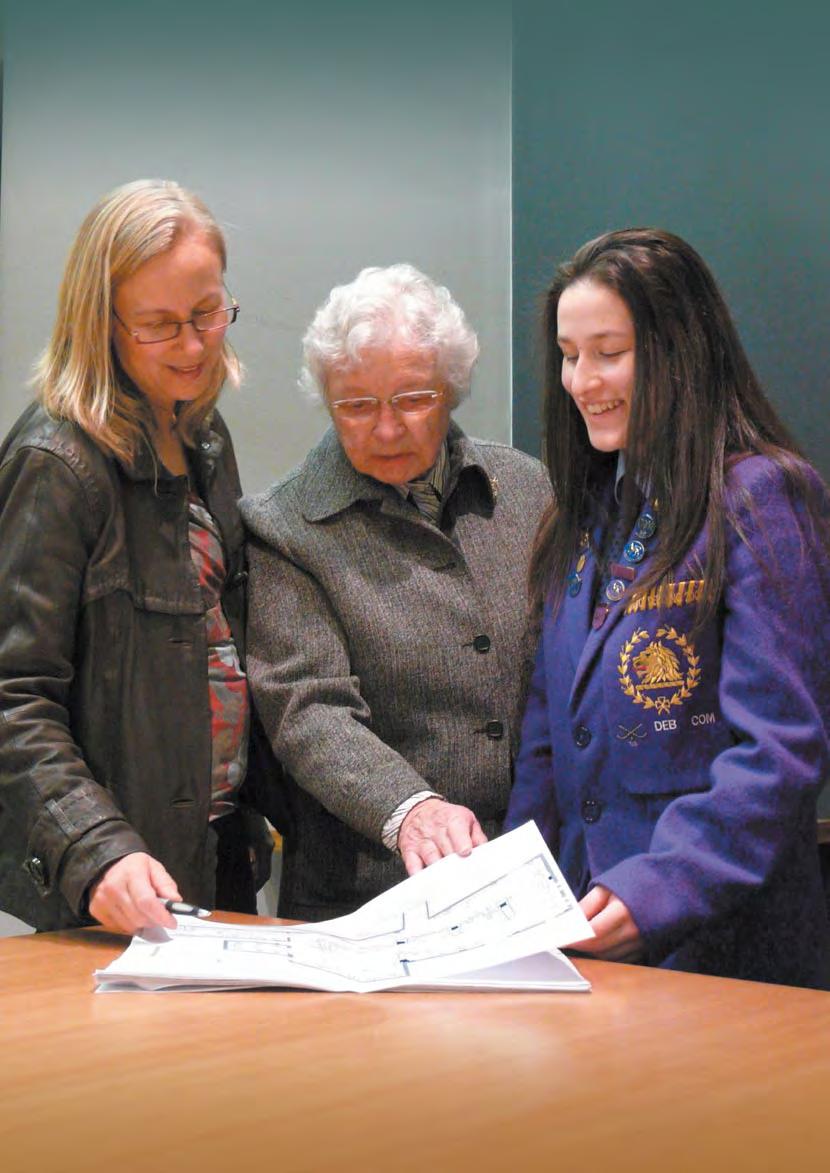
survivors’ vision
Continuing the
September 2009
Registered by Australia Post. Publication No. VBH 7236
Jewish Holocaust Centre
JHC Board:
President: Pauline Rockman
Vice President: Alex Dafner
Immediate Past President:
Shmuel Rosenkranz
Secretary: Elly Brooks
Treasurer: David Cohen
Public Officer: Adam Kreuzer
Members: Allen Brostek, Abram Goldberg, Sue Hampel, Henri Korn, Willy Lermer, Helen Mahemoff

Executive Director: Bernard Korbman
JHC Foundation:
Chairperson:
Helen Mahemoff
Trustees:
Nina Bassat AM
Joey Borensztajn
Allen Brostek
Silvana Layton
Jeffrey Mahemoff AO
Patrons:
Professor Yehuda Bauer
Mrs Eva Besen AO
Mr Marc Besen AO
Sir William Deane AC CBE
Sir Gustav Nossal AC CBE
Mrs Diane Shteinman AM
Steven Spielberg
JHC Staff:
Bernard Korbman, Executive Director
Zvi Civins, Director of Education
Jayne Josem,Curator, Head of Collections
Phillip Maisel OAM, Head of Testimonies
Ursula Flicker OAM, Head of Archives
Sabina Josem & Rosa Freilich, Librarians
Nicole Brittain, Development Manager
Frankie Pinch, PR and Communications
Manager
Robyn Fetter, Finance Manager
Lena Fiszman, Office and IT Manager
Tosca Birnbaum, Reception
Claude Fromm, Assistant Archivist
Rae Silverstein, Volunteer Co-Ordinator
Centre News Editorial Commitee:
Editor: Ruth Mushin
Pauline Rockman
Bernard Korbman
Lena Fiszman
Jayne Josem
Frankie Pinch
Nicole Brittain
Moshe Ajzenbud (Yiddish)
On the cover:
Three generations at JHC: (l–r) Jayne Josem, Curator, Head of Collections; Saba Feniger, the Museum’s first Curator; Lior Hadar, volunteer.
The Jewish Holocaust Centre is dedicated to the memory of the six million Jews murdered by the Nazis and their collaborators between 1933 and 1945.
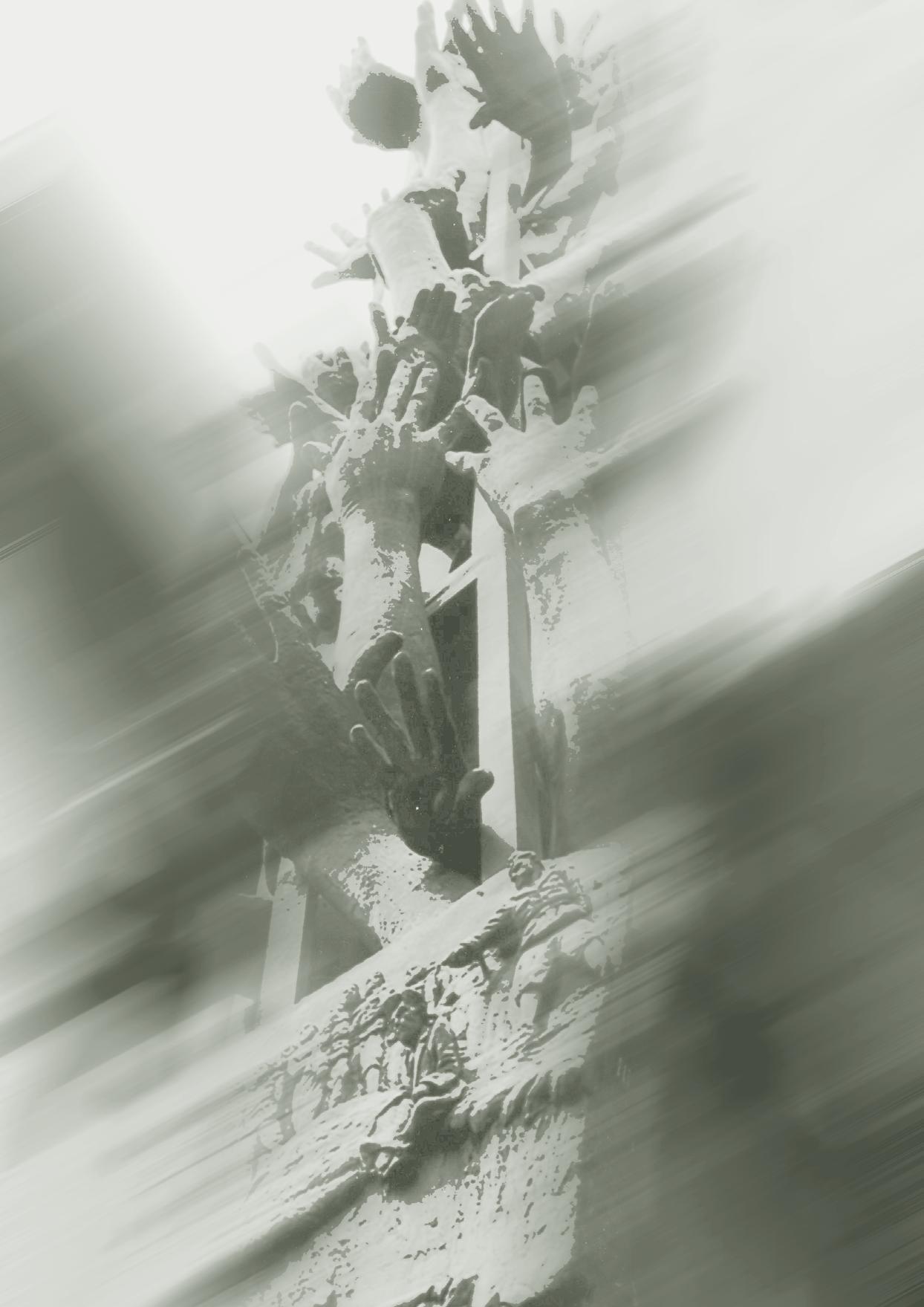
We consider the finest memorial to all victims of racist policies to be an educational programme which aims to combat anti-Semitism, racism and prejudice in the community and fosters understanding between people.
13–15 Selwyn Street, Elsternwick, Vic 3185, Australia
t: (03) 9528 1985
f: (03) 9528 3758
e: admin@jhc.org.au
w: www.jhc.org.au
OPENING HOURS Mon–Thu: 10am–4pm Fri: 10am–2pm Sun & Public Hols: 12pm–4pm Closed on Saturdays, Jewish Holy Days and some Public Holidays JHC Centre News Disclaimer: The opinions expressed in Centre News are those of the authors and do not necessarily reflect those of the magazine editor or editorial committee. While the Centre News welcomes ideas, articles, photos, poetry and letters, it reserves the right to accept or reject material. There is no automatic acceptance of submissions. CONTENTS FROM THE PRESIDENT 3 EDITOR’S LETTER 3 DIRECTOR’S POINT OF VIEW 4 REMEMBERING THE CENTRE’S FOUNDERS 5 FABRIC OF THE FUTURE: ACKNOWLEDGING OUR SPONSORS 8 O, YE SUMMER OF ‘39 9 JHC – A JOURNEY OF DISCOVERY 10 SPOTS OF LIGHT: TO BE A WOMAN IN THE HOLOCAUST 11 OUT OF THE DARK: THE EMOTIONAL LEGACY OF THE HOLOCUAST 12 ABHIJIT CHATTARAJ – BRINGING A NEW VISION TO THE CENTRE 13 MUSEUM UPGRADE STATE OF PLAY 14 EDUCATION 16 MARCH OF THE LIVING 18 EVENTS 20 VOLUNTEERS 25 A WIN-WIN FOR AJAX FOOTBALL CLUB AND JHC 26 BEQUESTS 27 FRIENDS 28 SEEN AROUND THE CENTRE 30 COLLECTIONS 32 OBITUARY 35 THANKS 35 This
by Izigraphics Pty Ltd www.izigraphics.com.au
publication has been designed and produced
Pauline Rockman

Ioften talk about the buzz I encounter when I enter the Jewish Holocaust Centre. It seems that buzz has developed into a roar; the excitement at the Centre is palpable and has taken on a life of its own. One of the volunteer guides said to me: ‘I always love coming to work at the Centre but at the moment it is so exciting I can’t wait to get here each week.’
From the outset our 25th year has been an outstanding success, from the Chazanut concert in February to the 25th anniversary dinner in March that launched it all. There have been many highlights throughout this time. We witnessed the passing of the baton at the tribute dinner as survivor Abe Goldberg handed over to third generation Adam Kreuzer, representing the future of our Centre.
There was the survivors’ Seder, the Open Day at the Centre, Rachel Berger’s fantastic one-woman show and HOLAGIF, the Holocaust And Genocide International Film event. And in October we will be launching Spots of Light: To Be a Woman in the Holocaust exhibition.
EDITOR’S LETTER
Success such as this doesn’t just happen but is the result of painstaking, exacting planning and very hard work. I want to thank all the JHC family – our survivors, all our volunteers, staff and Board for working so well together to produce it all, and the community for supporting our Centre.
The celebratory activities will culminate in the launch of our newlook museum early in 2010. The new permanent museum display is being developed by the Centre’s Curator, Jayne Josem, who is working closely with the Education Director, Zvi Civins, and a team of staff and volunteers. The museum will incorporate innovative and interactive technology, together with traditional exhibits.
A highlight of the new museum will be the interactive StoryPods which will enable visitors to discover the stories of our survivor guides in a highly innovative presentation. As I contemplate these amazing StoryPods, I wonder what led Abhijat Chattaraj, their creator, to our door. What prompted him to create and deliver this outstanding facility, these StoryPods? Dare we say serendipitous? I think so!
You will read about the amazing story of Abhijit’s involvement in the Centre in this Centre News. Abhijit first came to the JHC to photograph survivors and at the time, he suggested to us that our museum could benefit from the introduction of technology, so he brought in
his boss from a company called Philology for a chat. Serendipity! This meeting lead to the beginning of a pilot project that Abhijit named StoryPod – and in June we launched the pilot version, created with the idea of combining the Jewish tradition of storytelling with the technology of the iPod generation. The first contains seven survivor stories, but we hope to be able to honour all our survivor guides in the future by preserving their stories in these StoryPods.
As you read this edition I will have returned from a special journey. Together with my sister and all my first cousins on my father’s side, we are going to Magdeburg, Germany, to take part in a ceremony created by the Magdeburg City Council. As in some large cities in Germany, like Berlin, there is a program of identifying and acknowledging former Jewish residents and telling their story in a very public way. The Magdeburg Council has inaugurated a commemoration program of erecting name tiles. On 11 September, a plaque will be unveiled outside the former residence of my great grandfather, Mechel Herz (who was murdered in Theresienstadt) and his son and three children (who were murdered at Auschwitz).
On behalf of myself and the JHC Board, I want to extend to you all L’shana Tova, wishing you and the whole world a happy and peaceful New Year.
are involved as guides, volunteers, Board members and as mentors to the staff, and the second and third generations, who include paid staff, Board members and volunteers. This edition covers a time span of seventy years, from the outbreak of World War II to the present, and highlights the involvement of the three generations in the Centre.
us some insight into life as the children of survivors, while Mark Regev, grandson of Mina Fink, salutes his grandmother’s role in establishing the Centre.
Visitors to the Jewish Holocaust Centre often use words like ‘energy’, ‘drive’ and ‘passion’ to describe it. These reactions are the result of many things, but for me, one of the very special things is the involvement of people of all ages, spanning three generations: the first generation of survivors who
Kitia Altman writes a moving account of the impact on her of the outbreak of war on 1 September 1939, while Moshe Ajzenbud reflects on the establishment of the JHC in 1984.

Mooky Bialylew and Nuritt Borsky, children of Aron Sokolowicz, talk about their father’s role in establishing the Centre and give
To reflect the increasing involvement of the younger generation, we feature the stories of Eileen Wright and Abhijit Chattaraj, two people who in different ways have made a remarkable contribution to the Centre as volunteers. The story of the AJAX Football Club’s involvement is another example of a special relationship between the Centre and the younger generation.
JHC Centre News 3 FROM THE PRESIDENT
Ruth Mushin
In this our twenty-sixth year it is important to reflect and to ask ourselves the question – after a generation of service to the Australian community, how have we evolved?
It is my view that through teaching about the Holocaust and close adherence to our Mission Statement, we have become an institution which is committed to providing a set of ethical principles which is beneficial for all members of our diverse and pluralist society. Furthermore, and I say this with a great deal of satisfaction, the Jewish Holocaust Centre has achieved this by being steadfastly true to the Jewish philosophical precept of tikkun olam, mending the world.
Tikkun olam, the ethic of responsibility, is the basis of human rights in Judaism and is at the core of any action taken by an individual or collective. Through the historical narrative and the personal experiences of Holocaust survivors, students and other visitors are constantly presented with ethical dilemmas, both specific to the Holocaust and to current community and global issues.
The Jewish Holocaust Centre, through its museum and education program, tries to act as a ‘change
agent’ for those who hold antisocial views such as racism and anti-Semitism. More often than not, these views are based purely on ignorance and often derived from centuries old myths now being disseminated through modern technology by hate mongers and bigots.
Our sages said that a single life is like a universe, therefore save a life and you save a world. Like them, we believe that if we can change just one life, we begin to change the world. Our notion of tikkun olam was born in the despair of the killing fields of Western Ukraine, in hiding in towns and forests, in partisan groups, in ghettos and in death camps. In the memory of all those who were murdered and, in the tortured memories and bodies of our Holocaust survivors, the will to make a difference was born.
Our approach to taking responsibility for one’s action and to never be a bystander is based steeply on the Jewish notion of human rights which differs in its approach and definition from the United Nations’ charter on human rights and from secular humanism in general. In Judaism we do not state that it is the right of every person to not go hungry or to be fed. In Judaism it is our ‘duty to feed’. It is not the right of every child to be educated, but it is our ‘duty to educate’. In other words the onus is on us. We must take responsibility; we cannot be bystanders; we must be active participants in life and with the world around us. Words can be cheap, but action speaks.
Thus, the program designed by the Jewish Holocaust Centre, based on
the brutality suffered by the Jewish people during the Holocaust is a call to action for all peoples of our multicultural and multi-faith community to actively participate with one voice to combat antiSemitism, racism and prejudice wherever and whenever it occurs. After twenty-five years we remain a proudly Jewish organisation with a message of relevance for all Australians.
* * *
This year, two greatly admired Jewish men in Australia passed away: the late Richard Pratt and the late Victor Smorgon. Both Mr Pratt and Mr Smorgon were more than generous benefactors and philanthropists, both to the Jewish Holocaust Centre and to countless other causes. I was going to list the major institutions and causes they supported, but it soon became apparent this was an impossible task. There is not one area of Australian life that has not benefited from the support of the Pratt Foundation or the different branches of the Smorgon Family foundations and trusts.
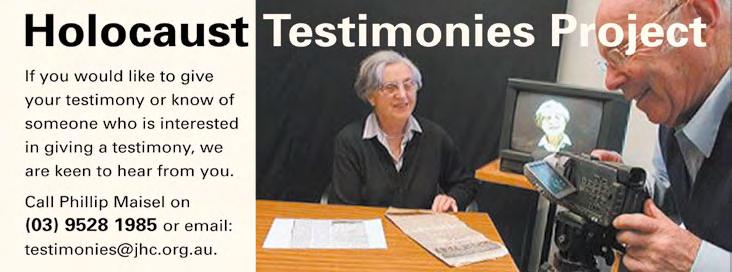
Perhaps of even greater importance is the strength of conviction Mr and Mrs Pratt and Mr and Mrs Smorgon placed in the second verse of the Shemah: ‘and you shall teach your children and your children’s children.’ As all Australians know, the Pratt and Smorgon legacy lives on through the tireless efforts of the younger generation of Pratts, Smorgons and associated families who have embraced that beautiful Jewish dictum, tikkun olam Z’’L (May their memory be a blessing).
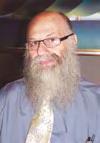
JHC Centre News 4
DIRECTOR’S POINT OF VIEW
Bernard Korbman
Remembering the Centre’s Founders
In March 2009, the Jewish Holocaust Centre began a year of 25th anniversary celebrations with a dinner to honour the Centre’s founders and celebrate the Centre’s achievements since its establishment. The founders were represented by three generations. Moshe Ajzenbud, the last remaining member of the first Executive, speaking in Yiddish, represented Bono Wiener and the survivor generation; Nuritt Borsky and Mooky Bialylew, Aron Sokolowicz’s daughters, represented their father and the second generation; and Mark Regev, grandson of Mina Fink, represented his grandmother and the third generation (by video link from Israel).
Saluting the Founders Moshe Ajzenbud
The 25th anniversary of the Jewish Holocaust Centre is a fitting time to remember and pay tribute to the Centre’s founders. During the initial stages of planning and establishing the Centre, those of us who were involved came from different backgrounds with our unique experiences and individual notions about the role of such a centre. However, we all shared an understanding of the purpose of the institution.
Whilst many people worked hard in those early stages, above all, we should stress the contribution of Mina Fink who was the inspiration for the establishment of the Centre. She was also the one who recruited the guides and generated the interest in the education community.
The first executive consisted of three representatives from the Kadimah and three from the Association of Polish Jews. The constitution of the Centre perpetuates their names – they were the two co-presidents, Aron Sokolowicz and Bono Wiener; two treasurers, Misha Ekhaus and

Hershel Bachrach; and two secretaries, Chanina Binsztok and myself. The opening of the Centre took place in the courtyard of the Kadimah in the presence of a large audience. Today, twenty-five years later, I can still sense the same degree of enthusiasm.
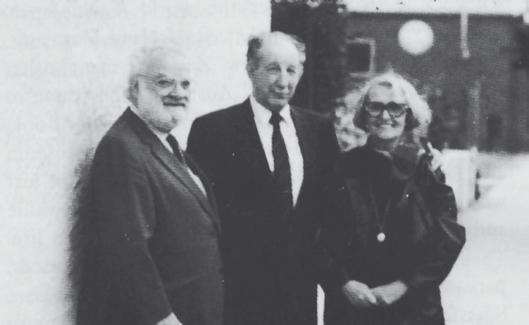
One person who played an extraordinary role in the Centre was Meyer Burston. He commanded a special talent for collecting funds for the institution, a fact that was extremely important for the building projects that were planned. Ordinary people saw in Meyer a person who could be trusted with money, so they contributed the funds. That was essential in those days, just as it is today.
The importance of the Centre had not diminished during its twenty-five years. On the contrary, witnessing the recent storm that erupted as a result of the Pope rehabilitating a Holocaust-denying bishop, it is clear that the Centre still has a vital role to play: to guard the honour of the victims of the Holocaust and to do everything possible to prevent a repetition of such horrors.
It gives me great satisfaction to salute both the founders and all those who are continuing their important work.
JHC Centre News 5
FEATURE
Committee meeting 1984
Victor Smorgon, Bono Wiener and Mina Fink at the Centre
Ensuring the World Would Never Forget
Mooky Bialylew
and Nuritt Borsky
Life can change in a moment in time and a quiet unsung act of heroism can have far reaching consequences. Rajzner in his book on the extermination of the Bialystoker Jews related the following incident: ‘Aron Sokolowicz a young Bialystoker had been selected for the transport to Birkenau gas chambers. At the time he was beside himself with anguish, so much so that Zishe Bagish a well-known Bialystoker artist and writer noticed him. Bagish, his own eyes full of tears, gestured for the younger man to approach him. “You are younger and healthier than I am,” Bagish told him, “and I am already weak and cannot survive the strain of this much longer. I am willing to help you live. When they call you for the transport to Birkenau I am prepared to take your place. This will at least give me the chance to save a fellow Jew.”’ That night when the Nazis called out for Sokolowicz, Bagish stood up. The two men embraced, said their farewells, and Bagish left.
Aron Sokolowicz survived the war. Perhaps it was at this moment that Aron’s passion was born, or perhaps it was always there and just needed to find its outlet. But having survived the war his life’s purpose became to ‘tell the story’, to ensure the world would never forget what he and his fellow Jews had seen and endured.
Those few who survived the horrors of Auschwitz will testify that Aron’s passion for life enabled him to endure the inhuman conditions from 1942 till the end of 1944. Aron’s irrepressible spirit kept him alive despite the loss of his wife and young son, and he inspired many others to keep going from day to day.
It was through talking with other survivors that we got a sense of the life force within him during his years in concentration camp. One survivor remembered how he felt particularly drawn to Aron as he witnessed his energetic debating and arguing about politics with other inmates. This was certainly typical of Aron – intelligent, opinionated, argumentative and fully engaged with life even in this dehumanising context.
In late 1944, after the liquidation of Auschwitz, Aron survived the Death March to Czechoslovakia and was transported to Ebensee in Austria where he was liberated by the Americans. The displaced Jews, some 7000 people, were relocated in the south of Italy in a displaced persons camp. This is where our parents, Aron and Cyla, met and were subsequently married. According to the testimony of other survivors still living in Melbourne today, Aron’s great leadership qualities were displayed there, and he was elected President of the camp. He assisted many Jews in successfully migrating to Israel, where he himself later settled.
Even prior to his relocation from Ebensee he had already begun to collect Nazi photographs and other memorabilia. Most of these were photographs that had been taken
by the Germans themselves. These artefacts became part of a mobile Holocaust exhibition which was held at Beth Weizmann every year and were later to form the foundations of the current Jewish Holocaust Centre collection.
Preparation for these exhibitions was always a family effort. Aron would recruit us – his daughters – to remove all the photos and memorabilia from our bedroom cupboards where they were stored. We then assisted him to mount and prepare these items for the ensuing exhibition. We were very reluctant recruits. At the time we did not fully appreciate the importance of what he was doing, and viewing the material repeatedly during our childhood years was a difficult and confronting experience. Nonetheless hundreds of people viewed these exhibitions and Aron slowly began to conceive of a plan for a permanent Holocaust memorial.
In her diaries our mother, Cyla, expressed her admiration for his energy and single-mindedness, but found it difficult at times to understand his level of obsession with this mission and the resultant cost exacted on family life.
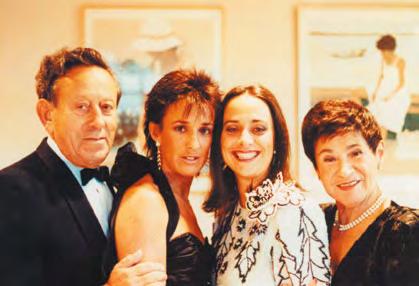
Aron was also an active and influential leader in the Melbourne Jewish community. He was President of the Federation of Polish Jews; Chairman of Yiddish culture on the State Zionist Council and Zionist Federation; Australian delegate to the World Federation of Polish Jews and the World Zionist Organization … and the list goes on. He wrote and published Yiddish newsletters and journals and created for himself a worldwide Jewish network.
With his extensive contacts both in Australia and overseas, he began to develop his plans for a Holocaust Centre. This grew into his life passion and he could think of nothing else.
In the late 1970s Aron, with the support of the Federation of Polish Jews, purchased a site in Glenhuntly Road, South Caulfield, and with the help of an architect, developed a model for the proposed museum.
A major appeal was planned and prepared. At that time Aron was approached by the Kadimah with the offer to lease the land behind their centre in Elsternwick. The original plans were altered and the Jewish Holocaust Centre was born. Aron’s work had only just begun. As a founding president he continued to work for the growth and development of the centre every day of his life thereafter.
JHC Centre News 6
Aron Sokolowicz:
Aron and Cyla Sokolowicz with their daughters Mooky and Nuritt, 1989
His energy was boundless and, whilst he was able to inspire and involve others, many of those who worked closely with him would agree that he was not always the easiest person to get along with. Cyla wrote in her diary: ‘Aron often enrages me … but he also amazes me. He has the courage of his convictions and most importantly he is never torn by doubts about whether he is right or wrong.’
Cyla became the first and founding editor of Centre News and supported him in his important mission. She wrote in her diary about the opening of the centre in 1984: ‘Aron was sitting for a couple of hours hammering away on his Yiddish typewriter the speech he has to deliver this afternoon on the occasion of the official opening of the Holocaust Centre. The last couple of weeks have been very hectic for him … all the thousands of preparations and upsets connected with getting everything ready on time … he really deserves admiration and respect for what he has accomplished. The problem now is that his baby has outgrown him and he is in no position to hold it and control it, a thing Aron finds hard to accept.’
If Aron could see the Jewish Holocaust Centre today it would exceed his wildest dreams and expectations. He would marvel at the premises, facilities, technology and the number of people of all ages who have become involved on a daily basis. He would be amazed at the efforts that have ensured the financial survival of the museum in perpetuity and would feel gratified that the next generation could so capably steer the museum into the 21st century.
In speaking of the museum Aron said, ‘This memorial will soothe our spirits and give us a place to honour and commemorate our near and dear ones who have no graves of their own.’
This Centre reflects the triumph of our survival as a people and our ability to rise from the ashes and rebuild our communities. The dedication and commitment of all those who have been involved in the development and running of this Centre has indeed led to the creation of a memorial, a matzevah for those without graves and, most importantly, has ensured that the world will never be allowed to forget.
Mina Fink: A Life Dedicated to Helping Others Mark Regev
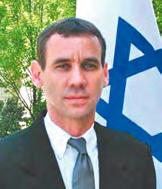
Usually when I speak in public, it is on behalf of the State of Israel, but now I am speaking on behalf of my family, to say a few words about my grandmother, Mina Fink, who was a driving force behind the establishment of the Jewish Holocaust Centre in Melbourne.
I remember my grandmother, Mina, as a grandmother – as someone who cooked for me, who spoilt me. Ultimately, as I grew older, I understood that she was, indeed, a very special person, a person who dedicated her entire life to the community, to the Jewish community and to helping others.
Mina left Poland almost a decade before the Holocaust and I know that she counted herself as lucky for having fled Europe before the inferno, that her life was saved. She knew that she was fortunate, and she knew that almost everyone left behind did not have the same luck, that they would perish in the Nazi inferno. So, my grandmother always saw herself as a survivor and that is why it was so important for her to do whatever she could to help those survivors who reached Australia’s shore after World War II. Mina’s goal was to help survivors to rebuild their lives, to integrate into Australian society and to become productive members of the community. She would go to Station Pier in Melbourne to meet the immigrants’ ships and she would do whatever was needed to assist those new arrivals. As most of us know, she was especially active in helping children – the orphans of the Holocaust. The most famous group of children was the group known as the ‘Buchenwald Boys’. My grandmother really adopted those boys and, in many ways, she became their surrogate mother.
As her grandson, I am very proud of Mina, as is her whole family. We are proud of her contribution to so many individuals, for the help she gave them after the Holocaust so that they could get their lives together and once again become productive and contributing members of the community.
So on behalf of my parents, Freda and Martin Freiberg, my uncle and aunt Nathan and Elly Fink, all my siblings, my cousin Michael – Mina’s grandchildren – and her great grandchildren, Mina, we thank you for what you did and we thank you for your part in helping to create this important Jewish Holocaust Centre in Melbourne.
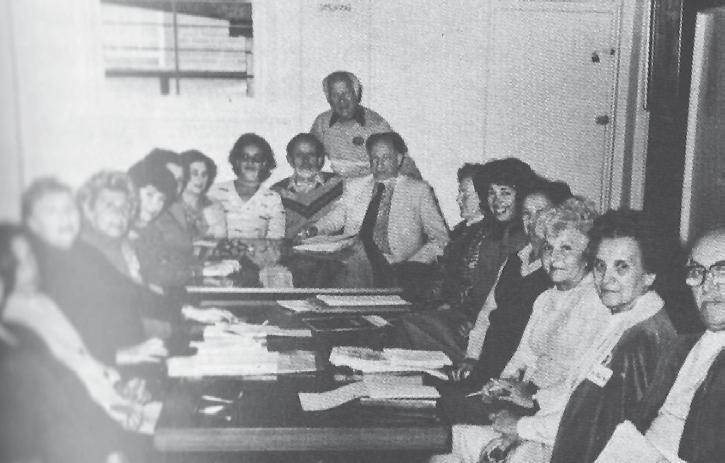
JHC Centre News 7
Gathering in 1984 to discuss the proposed Jewish Holocaust Centre
Mark Regev
Fabric of the Future
Since 1984, the Jewish Holocaust Centre has proudly welcomed almost half a million people through its doors. We attribute our growth to the vision of the founders together with the many survivors, volunteers and supporters who have woven the
fabric of the Centre – in a physical, emotional and moral sense.
During this year of 25th anniversary celebrations, we have nominated a variety of fabrics to represent supporters of the full year or individual events.
The Jewish Holocaust Centre acknowledges and appreciates the generosity of the following sponsors:
The Helen and Boris Liberman Family Cashmere
The Jack and Robert Smorgon Families Foundation
Sunraysia Foundation in memory of J and D Randa
Astoria Honda Satin
Classic Cinemas
Arnold Bloch Leibler Solicitors
Suzi and Barry Carp
Melma and Berni Hamersfeld
Helen and Jeffrey Mahemoff
Pauline and Sean Rockman & Sandra and Vernon Jedwab
Anita and Danny Selzer
Diana Strauss
Friends of the Jewish Holocaust Centre
DBR Corporation - The David, Barry and Rodney Smorgon Families
JHC Centre News 8
Cashmere
Cashmere
Satin
Lace
Lace
Lace
Lace
Lace
Lace
Lace
Lace
Velvet
Bank Leumi
Velvet FVG Velvet
Charitable Trust Velvet Metro Diamonds Australia Pty Ltd Velvet
Peer and Associates Velvet
Velvet
The Marin
Gary
Victorian Multicultural Commission
Kitia Altman
September 1 marked the 70th anniversary of the outbreak of World War II. Here Kitia Altman remembers that fateful summer in her birthplace, Bedzin, Poland.
The summer of the beginning, so short and sweet, and the end, so sudden and final, of my youth. The summer of the end of my school years. The summer of many emotions, tremulous and exciting, quivering with anticipation of tomorrows. The summer of ’39. June. The final exams are over. We have our Matura (Certificate of Maturity) and all of a sudden I find myself in a circle of university students home for summer vacation. I am embarrassed and flattered at the same time. As if overnight I’ve changed from a teenager in a school uniform into a young woman. I go to my first party, given by my cousin, ten years older than I. I am shy and feel awkward. I get presents and flowers from my family and older friends. One present has remained in my memory: six Swiss handkerchiefs with paisley designs on dark backgrounds of navy, red and green. I love it!
Mama gets ready to go to Truskawiec to rest after the preexam tension and before my forthcoming departure to Paris. I am scared of being alone, in a new country, with no knowledge of the language, without my parents, aunts and friends. I am not an adolescent anymore, but neither am I an adult.
Everybody is restless, but we are sure that whatever happens Poland is strong enough to fight and win. There is talk of Hitler and his territorial demands, his speeches of Jew-hatred. That we already know. Hasn’t he expelled German Jews of Polish origin? The word war is heard more and more often. It still spells w-a-r, not horror. People remember the First World War. That war was fought at the front, far away from us. My father thinks that Hitler is a passing disease – German people with their innate sense of decency, honour and righteousness will not endure the Nazis for long. Still, war is becoming more of a reality.
August comes in full glory of sunshine, smells of harvest and fresh hay. In his letters my boyfriend writes seriously about our future. I am meeting new, interesting people and am not ready for commitment. Dr Einhorn, director of my school, rings my father to advise him to postpone my departure to Paris.
My boyfriend arrives from Krakow to take me with him further east. The day is warm, the sky cloudless and blue. We go to the Castle Hill Park to walk, talk and kiss. He has a camera to take a photo of me. I am wearing a new dress: wide navy and white stripes attractively arranged by the dressmaker. I stand under a tree, on a small hillock; above me the sky and in front of me – I am looking forward, perhaps for the first time during that summer of ’39, with confidence into the future!
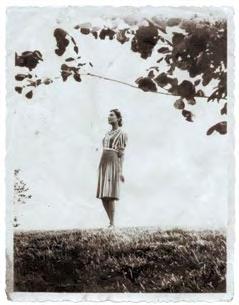
August – only a few days left. So much is happening! A lot of packing, carpets are rolled up, everybody is nervous, restless or distraught.
I don’t remember how or when my mother leaves with all the boxes for Piotrkow. Suddenly panic erupts. I run upstairs to Aunt Adela and she too is ready to leave. Where? How? Suitcases are full and she stuffs things into pillowcases. I still see her now. I run across the street to my other aunt. The same scene welcomes me: chaos, tears,
packing. Hardly anyone pays attention to me. I run back home.
‘Tata, they are all leaving, running away, what about us?’ ‘Start packing, only the bare necessities.’
What are ‘necessities’? I’ve never packed anything and I don’t know what to put in my rucksack. I grab the six new handkerchiefs, and Annette and Sylvia, a book by Romain Rolland. What else? Comb, brush, toothbrush, maybe soap? A towel. Yes, a towel or two.
‘Hurry up! We’re going!’
‘Where to? How?’
‘We’re going on foot to Miechow.’
‘How far is that, who is there?’
My father gives me last minute instructions: ‘Keep going with the people. We’ll meet in the city square in Miechow, look for Piekna Karola, remember!’ The beautiful Karola –my cousin.
Germans have crossed the border. We are swallowed up by a disoriented, screaming and weeping wave of terrified humanity. I desperately try to hold on to my father’s sleeve. The pressure of the moving masses separates us. I am pushed forward, calling my father. I don’t know anyone, no one knows me – I am alone, alone and abandoned for the first time in my life!
O, ye summer of ’39! The first taste of being a refugee, of being an anonymous individual among an ocean of strangers. German planes fly low. I can see the impassive face of the young pilot. We run to the ditches expecting bombs. Panic and chaos, torn hem of my dress. How do I look? Tears flowing on my dirty face, my elbows are scratched and bleeding, I am frightened and distraught. How far is Miechow? Where is my father?
The first day of the war is coming to an end, a day without a night. Bluish-grey dusk descends on the tired, resigned, on the now slowly moving, bedraggled mass of humanity. And then suddenly there is Miechow, people walking around aimlessly, disoriented and surprised at the wave after wave of strangers arriving in their little town.
In the end I found – I don’t know how anymore – the beautiful Karola. She took me to her home, gave me food, washed my face. Her house was full of people sitting wherever there was an empty spot. Karola put me down on the floor in the passage and covered me with a blanket.
This is where I was on the first day of the war that changed the world. Isn’t there a statute of limitations for memories?
O, Ye Summer of
’39
JHC Centre News 9
JHC – A Journey of Discovery
This year marks ten years of my involvement at the Jewish Holocaust Centre. In 1998 I took a Holocaust studies unit during my Arts degree at Deakin University and was unexpectedly overwhelmed by an interest in this area. This interest has changed the direction of my work life and has also had a personal impact.
In 1999 I first came to the museum and soon after, I began volunteering in the Testimonies Department. My memories of that time are still keen – my sense of awe that this was a place of memory run almost totally by survivors; the first two people I met – Fryda Schweitzer and Zosia Gettler, who were both so gentle and kind in introducing me to the museum. No security guards, no modern building, just friendly people and a low-tech, lovingly hand-made exhibition. Not being Jewish, or having any involvement with the Jewish community, the museum opened up a whole new world. Going there once a week helped me not only to learn more about the Holocaust, but gradually, to navigate my own family’s hidden past.
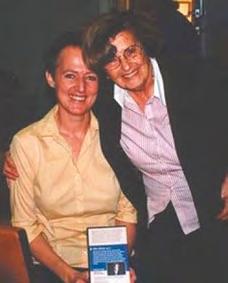
In 2000, I decided to do my Honours year research project on the guiding practices at the museum, focussing on the transition from survivor to non-survivor guides. I was enthralled by the process of survivors giving succinct personal accounts of their experiences to students, allowing young people an entry point into a complex and alienating history.
By this time, my involvement had drawn my mother, Sue Wright, into the Centre. Born in 1930 in Vienna, and having two Jewish grandparents, the Third Reich classed her as a ‘Mischling first degree’. Her mother was Catholic and her father, Peter Friedländer, was Jewish. Peter was taken to Izbica in 1942 and was probably killed in Belzec. Peter’s two brothers were also murdered, and my mother’s Catholic grandfather died in Auschwitz for assisting Jews to escape Austria.
Although people assume my family background is the reason for my involvement in the Holocaust Centre, it was not quite that simple. Much of what I now know about my family from that period I have learnt only in recent years. My mother had repressed her memories after the war, so she did not share them with her children. Growing up, all we knew was that she did not like to see anything about the war on television. It is hard to explain how you can know, but at the same time not know something, yet that was how it was. It was a subject never spoken of in our family and I have no clear recollection of when I was told that my grandfather died in a concentration camp. I certainly knew nothing of the fate of other family members. Of her own accord, however, my mother tentatively began to revisit her past, first by coming to the Centre and then by joining the Child Survivors’ group after being encouraged to do so by Eva Marks.
By 2002, my degree was over, yet my admiration for the Centre’s guides led me to become involved in a project to record their stories for educational use. Together with Dora
Oliver, my mother and I embarked upon the Eyewitness Project. Initially we conducted filmed interviews with twenty-six survivor guides, but this has now grown to forty 15–20 minute edited survivor videos. We have also produced a set of twelve educational support kits. This year, Education Director Zvi Civins is assisting us to develop these kits, each consisting of a DVD with three survivor stories and a printed booklet of historical background information and educational activities specifically linked to the individual stories.
I have also worked with Jayne Josem, Curator and Head of Collections, on two temporary exhibitions: ‘Bittersweet Freedom: Memories of Liberation 1944-45’ (2005), which explored the ramifications of liberation, and ‘Shelter from the Storm: Jewish refugees 1933-45’ (2007), which focussed on the experiences of Jews who managed to escape to Australia during the Nazi era.
Over the past few years I have worked on historical and film projects for the Immigration Museum, the Anglican Diocese of Melbourne and the City of Kingston. This work has been informed and enriched by what I have learnt at the Holocaust Centre – not just historical facts or museum practices, but more intangible things: survival, how people heal from and are able to speak about trauma and the transmission of memory and trauma between the generations.
In July this year I began full-time work at the Shrine of Remembrance in Melbourne as exhibitions researcher. There are many similarities between the organisations. Both fulfil a need in the community to have a place in which to grieve for family members who had no graves, both were established by individuals for whom the histories were very personal, and in both, volunteers play a pivotal role. My involvement with the Holocaust Centre continues and this year I have been fortunate to collaborate with Jayne Josem and Abhijit Chattaraj on the StoryPods and the Whispers in the Wind installations, as well as with photographer Andrew Harris, who is producing a series of photographs of survivors with tattoos.
I live in the western suburbs and it is not easy for me to come to the Centre often, but when I do it is always lovely to be greeted with warmth and to catch up with friends. Perhaps because I have never known any of my grandparents, I have cherished the interactions with the survivors at the Centre. I feel lucky to have met so many people who I’ve learned from and who have in different ways been instrumental in changing the path of my life.
10 JHC Centre News
Eileen Wright
Eileen Wright and Kitia Altman
Spots of Light: To Be a Woman in the Holocaust

From October until the end of 2009, the Jewish Holocaust Centre is proud to host the Yad Vashem multimedia exhibition Spots of Light: To Be a Woman in the Holocaust. Two million women were murdered in the Holocaust and this exhibition focuses not upon what was perpetrated upon women but, as the exhibition curator Yehudit Inbar put it, ‘the response of these women to their devastating and extreme circumstances.’
The exhibition focuses on the themes of love, motherhood, caring for others, womanhood, partisans and underground, everyday life, friendship, faith, food and the arts, using personal accounts, excerpts from novels, letters and diaries, photos, artwork, artefacts and video displays.
One of the items featured in the exhibition is the diary of Regina Honigman, donated to Yad Vashem by her daughters, Fay Eichenbaum and Esther Gordon. Regina was born in 1918 in Zawiercie, a town near Krakow in Poland. She was sent to Gabersdorf slave labour camp in Sudentenland in 1942 when the family was ordered by the Nazis to give up one family member in return for saving the rest of the family. Apart from her brother Chaim Dovid, the rest of the family perished. At Gabersdorf, Regina worked at a factory which produced flax threads on spools using machines which operated from early morning until evening. Rations were meagre and camp conditions were harsh.
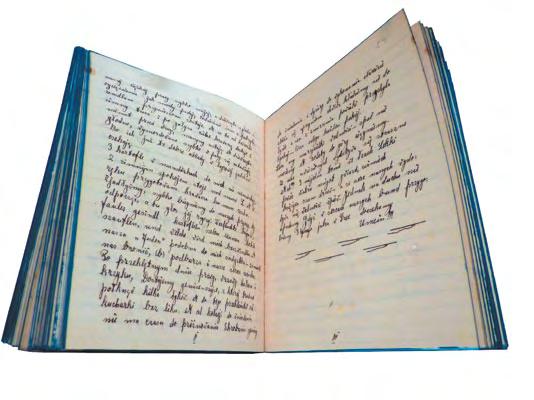

Regina was an inmate at Gabersdorf until liberation, when she was sent to Bergen-Belsen displaced persons camp. She married Elias Lustigman in Germany in 1947 and migrated to Australia where her two children, Esther and Fay, were born. She passed away in Melbourne in 1992.
Regina wrote her diary between 15 April 1942 and 1946. It is written in Polish, German and Hebrew, beautifully expressed and in beautiful handwriting. It contains personal reflections, poems, mock radio programs, comedy sketches and an ironic ABC, an alphabet of abuse in the camp. It even includes a Haggadah which Regina wrote from memory, also related to life in the camp. Regina would write her diary when she could not sleep at night, thinking about freedom and life before the war.
As well as her own writings, Regina also included moving messages from friends. On one page, Hela Cymbler wrote: And if I do not make an entry in your notebook, in your heart I will be forgotten. My dear Reginka, the moments that we spent together in the camp in Gabersdorf, I am making this entry for remembrance.
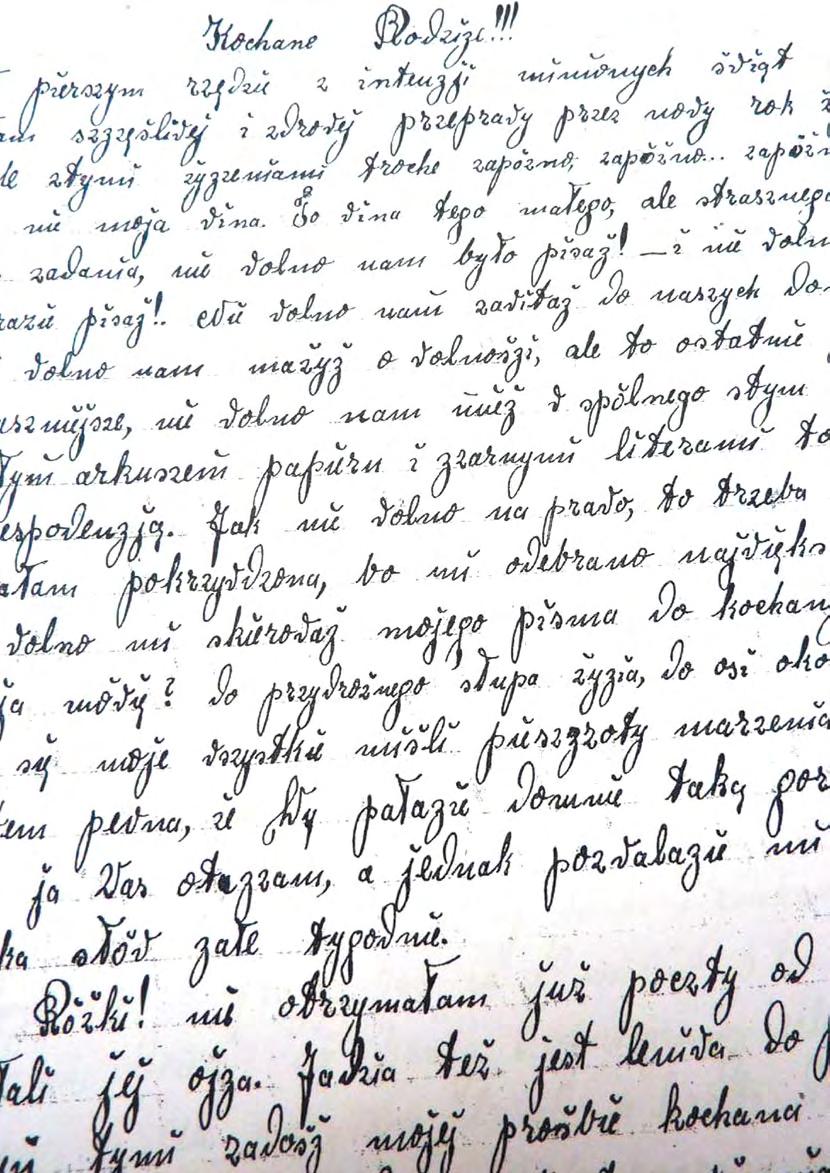
Somehow, Regina managed to keep the diary during her years in Gabersdorf. Fellow survivors from Gabersdorf living in Melbourne were amazed to find out that this diary existed and could not believe how she had the strength to even attempt to write after the sheer exhaustion of the work and conditions they all endured.
Spots of Light: To Be a Woman in the Holocaust exhibition opens on 18 October in the Smorgon Auditorium at the Jewish Holocaust Centre. For further information, please contact Tosca Birnbaum on (03) 9528 1985.
JHC Centre News 11
Regina Honigman, Bergen-Belsen, 1946
Out of the Dark: The Emotional Legacy of the Holocaust
The exhibition Out of the Dark: the Emotional Legacy of the Holocaust will be launched at the Cunningham Dax Collection in Parkville in October. It is the culmination of a collaborative project between the Jewish Holocaust Centre and the Cunningham Dax Collection that has been two years in the making. The project emerged from a conversation between Gail Rockman, an art therapist who had just begun to work with people affected by the Holocaust, and Dr Eugen Koh, the director of the Cunningham Dax Collection.
The Cunningham Dax Collection comprises 12,000 works, all of which have been made by people with experience of mental illness and/or trauma. The collection has developed over sixty years, beginning with works made in art therapy in psychiatric hospitals, collected by Dr Eric Cunningham Dax when these institutions were shut down in the 1980s.
Halasz (psychiatrist and project committee member) has noted:
First, despite the refrain after the Holocaust ‘never again’, it has become cliché, tragically, as we witness around the world ongoing genocides; second, the reality is that with each passing day the number of Holocaust survivors diminish. Fewer and fewer visual voices can claim to tell the story with the authority that can only come from saying ‘I was there’.
Out of the Dark brings together a selection of artworks made by survivors, child survivors and children of Holocaust survivors. The exhibition explores the continuing psychological effects that the Holocaust has had within and throughout these generations. Each person in the exhibition has a unique and compelling story of physical and mental survival and so, above all, the exhibition has a strong focus on the voices of the artists. The artworks have been made in a variety of contexts: in art therapy groups, by professional artists, and by non-professional artists working privately. One common theme, however, is the fact that the making of all the artwork has functioned as a form of therapy in some way. Whether or not this was a conscious
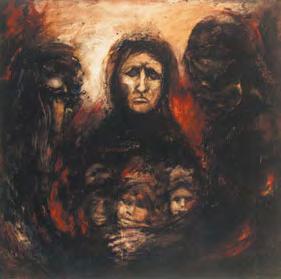
In recent years the collection has turned its attention to the psychological effects of trauma, and now holds work made by Sri Lankan children who survived the 2004 Asian tsunami, and a body of work by adults who experienced childhood sexual abuse.
In 2007 the Cunningham Dax Collection began working with the Jewish Holocaust Centre with the aim of acquiring a body of work made by people who had experience of the Holocaust. The main aim of the partnership was to raise public awareness of this terrible event in history, and to propagate a greater understanding of the long-term effects on the survivors and their families.
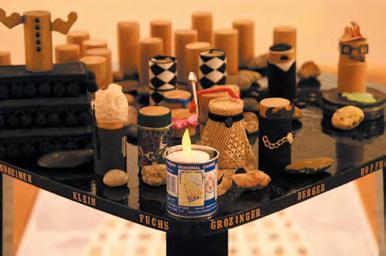
The partnership between the Cunningham Dax Collection and the Jewish Holocaust Centre was undertaken with a sense of ‘double urgency’ as George
motivation, all the works embody the process of dealing with trauma. The exhibition therefore explores the ways in which art has played a role in the psychological journey of each person and, furthermore, illustrates how art and creativity can be a source of empowerment both at a personal and political level.
The exhibition runs from 22 October 2009 until 23 January 2010. For further information, visit the JHC website at www.jhc.org.au or the Cunningham Dax Collection at www.daxcollection.org.au
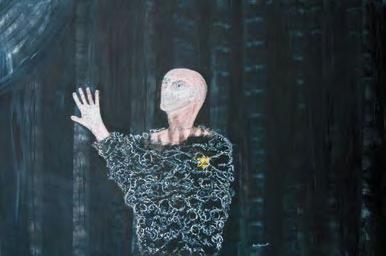
JHC Centre News 12
Robin Michaelson, 2008 Oil on canvas
Michelle Fox , 2009 Mixed media
Ruth Rich, c.2000 Oil on canvas
Abhijit Chattaraj – Bringing a New Vision to the Centre
Abhijit Chattaraj was born in Kolkata (Calcutta) but spent his early childhood living with his grandparents in Bihar, where his grandfather’s stories were a very important part of his life.
Abhijit’s grandfather was steeped in the Bengali tradition of storytelling, but his stories often had a Jewish theme. His own father had been to Europe and had known Jewish people, so they became part of the stories Abhijit heard. His grandfather’s sense of connection with Jewish people gave him an interest in the Holocaust, but he was also concerned about the violence in his own country related to religion. As a result, his grandfather instilled in Abhijit the importance of knowing about history and a strong sense of justice and tolerance. Abhijit was also fascinated by Ann Frank’s diary and even as a small child, he felt angry about injustice.
Abhijit came back to live with his parents at the age of six, and lived in Kolkata until he completed his undergraduate degree. He then continued his studies in Australia, arriving in Melbourne in 1999. After completing a Masters degree, he decided to continue studying and completed a PhD in informatics. Abhijit began working for Philology, a global technology research consultancy, but he also enrolled in a photography course, hoping to combine photography with his technical skills.
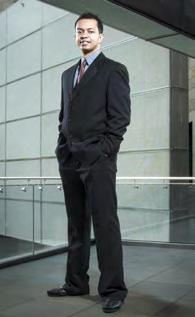
Before taking any photographs, he researched the history of his subjects so that he would know something about them when they met. And, while photographing them, he discovered that Jewish people too had a tradition of story telling.
The twelve portraits became the exhibition Whispers in the Wind, accompanied by a soundscape of fragments of each of the subjects’ testimonies. The exhibition opened in June this year and runs until the end of September.
Abhijit continued to search for ways of telling the survivors’ stories. He wanted to present the information in ‘bite sized chunks’ and particularly to make it accessible to students. Critically, Abhijit wanted museum visitors to get the same knot in their stomach he experienced on his first visit.

Gradually, Abhijit developed the idea of the StoryPod – an interactive and userfriendly touch screen kiosk to enable museum visitors to explore survivors’ stories. Searching for the best way to present the information, Abhijit had a ‘eureka’ moment in Holocaust survivor Phillip Maisel’s study. Looking at Phillip’s desk, he had the idea of creating the touchscreen as a 1930s style desk top with each object – a camera, diary, or watch – giving the user access to a module of information.

By this stage, Abhijit brought his director, Phillip Cookson, to the Centre. Even though Philology’s main focus is in providing technical solutions to corporate clients, Phillip was enthusiastic about the project and encouraged Abhijit to develop the StoryPod concept. Abhijit recruited RMIT graduates to help with the programming and input of masses of archival material supplied by the Jewish Holocaust Centre.
The StoryPods have captured the imagination of everyone involved in their creation, including Abhijit’s work and university colleagues. Abhijit and his team, working as volunteers, have now completed the pilot StoryPod featuring seven survivor stories. They are now developing two more to be incorporated into the upgraded museum, so that over twenty survivors’ stories will be accessible in the museum.
In July last year, Abhijit heard there was a Jewish Holocaust Centre in Melbourne so he decided to visit. He was shown around the museum by a survivor guide; it was the first time he had been in a museum with first person contact. Not only did he find it very moving, but he felt that he needed to become involved in the Centre in some way.
In the meantime, Abhijit continued with his work and photography. Although initially interested in fashion photography, a trip to Vietnam opened up other possibilities. There he became interested in the gulf between rich and poor and realised that he could use photography to tell stories about issues that really mattered to him.
Abhijit decided that he wanted to photograph portraits of Holocaust survivors, an idea that the Centre welcomed.
With a successful career in information technology and photography, Abhijit has come back to the Bengali tradition of story telling, combining that with his cutting-edge technological skills to create a meaningful and accessible way of enabling the survivors’ stories to be heard and for people – especially young people – to make a strong emotional connection with the survivors.
JHC Centre News 13
Abhijit Chattaraj
Museum Upgrade State of Play
The Jewish Holocaust Centre is on target to commence installing the new museum display at the end of 2009. Whilst the current museum display has had some changes over its twentyyear history, its style has not changed. The aim of this upgrade is not designed to change the substance of the museum, but to update the method of delivery of the information to appeal to the younger generation of visitors that make up the bulk of our audience.
First, we will be installing new carpet and painting the room white. This will instantly give the space a lift. A monochromatic palette has been chosen to express a sense of memorial, with its lightness providing some relief from the darkness of the story.
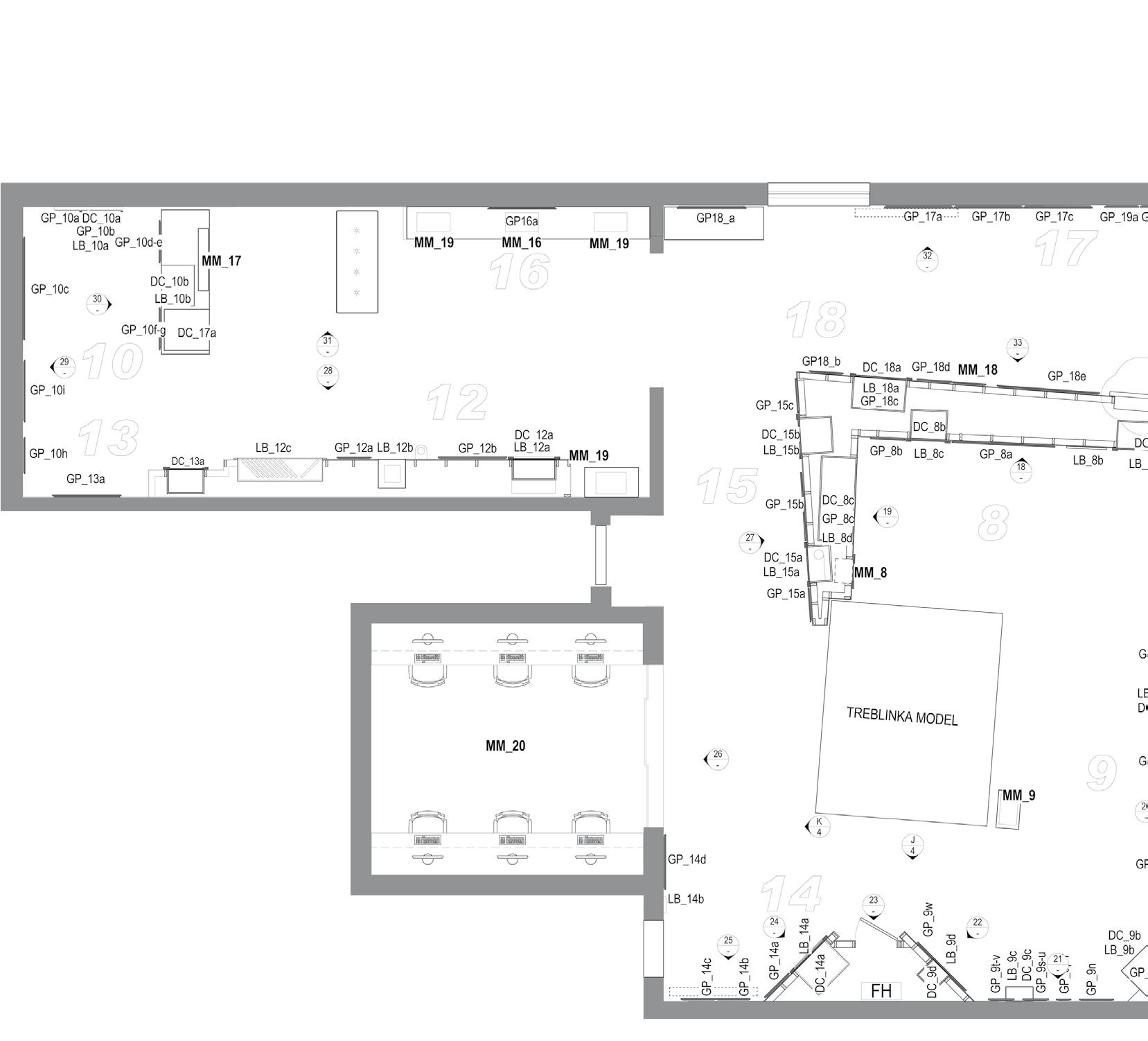
According to the exhibition designer, Martin Lilford of Lilford Smith, ‘The museum has been designed to guide visitors through the Holocaust in the order events unfolded. Angular walls serve to break up the journey and help to reinforce thematic changes. The simplicity and consistency of the museum’s design aims to assist visitors to focus on the content, providing clarity and room for reflection. Images, documents, artefacts, audiovisuals and the written word have been woven together to engage and inform. The display is punctuated by artworks that bring direct expression and emotion to the indescribable. Ultimately the museum serves to educate and provide a message of hope.’
The display panels are being designed by Izydor Marmur of Izigraphics to give a clear, modern presentation of the material. The text will be easier to read than in the current display and the photos will have more impact. Some of the photos are the same as currently on display, while others are being sourced from overseas archives; many from the pre- and post-war period come from our own archives. There are even a handful of precious photos of our survivors from the period of their imprisonment.
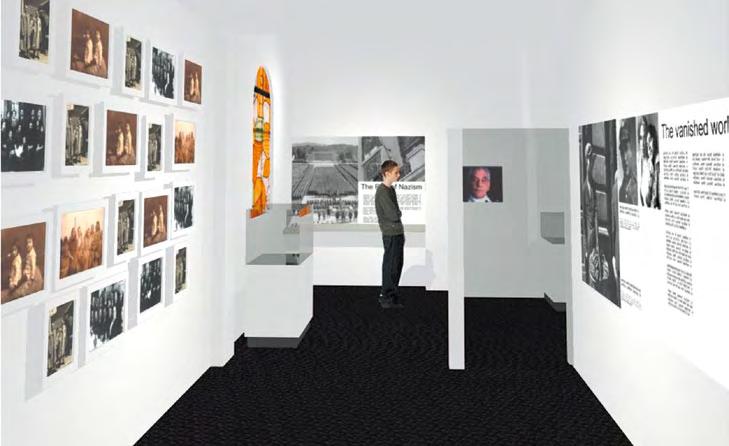
The museum text itself has been rewritten and JHC Curator, Jayne Josem, and Education Director, Zvi Civins, are grateful for the contribution of Dr Paul Bartrop, Dr Bill Anderson, Sue Hampel and Elaine Davidoff, who have all given their time freely to work on this most difficult job of finding the right words to succinctly convey so much material.
Display cases will be a major area of improvement, with purpose-built cases to show off some of the incredible documents and memorabilia we have in our archive, painstakingly collected over 25 years. This area displaying authentic primary source material – evidence of the crimes committed against the Jews – is one of the most important in the museum.
As in most new museums, there is modern technology, but we aim for it to complement the displays, not overtake them. We will use it to deliver eyewitness
JHC Centre News 14
testimony, to keep the survivors’ voices ever-present in the museum. There are four video stations, exploring the topics: (1) Rise and impact of Nazism on Jews, (2) Life in Ghettos, (3) Horror of the Camps and (4) Survival and Beyond.

We see technology as a tool to enable us to present levels of information that we simply do not have the space to display on our walls. Accordingly, there will be four interactive computer terminals. Two terminals will be dedicated to StoryPods, telling the stories of our survivor guides and incorporating their photos, memorabilia and documents. The other two computers will enable visitors to explore two important topics in-depth: (1) Stories of the Righteous Among the Nations and (2) Fate of Jewish Communities, a country-by-country exploration of the impact of the Holocaust. We are able to put a wealth of information into these interactive computers and visitors can choose what they look at according to their own interest. Students with Greek heritage, for example, might choose to focus on the fate of the Jews in Greece during the war and this will give them some food for thought and hopefully something to discuss with their family at home that evening. Similarly, someone of Muslim heritage might be curious about the Albanian Muslim who saved Jews during the war.
Throughout all of the upgrade, the main imperative is to educate the public not just by presenting the facts but also by relating it back to Melbourne Holocaust survivors who have donated much of the material on display. It is these glimpses into personal stories that we hope will have the most impact on the visitors.

The upgrade would not have been possible without the assistance which is being given by all levels of the organisation – the survivors and volunteers are so wonderful and inspiring, and the staff and Board are all behind the project 100%. Daniel Feldman, the new assistant to the Curator, has played a key role and has also taught us a lot about data management, project management and life management.
We look forward to delivering a shiny, comprehensive and thought-provoking museum in the first few months of 2010.

JHC Centre News 15
The images in this article are computer renderings of the new museum display. They are intended to give an idea of the interior design. Photos and text will be inserted on the blank panels. Produced by Lilford Smith Exhibition Design.
We consider the finest memorial to all victims of racist policies to be an educational program which aims to combat anti-Semitism, racism and prejudice in the community and foster understanding between people.
Many of you are familiar with the mission statement of the JHC and recognise my opening words as the second paragraph of the statement.
The question is: are we succeeding in our mission? Is there any sign of success? We see hundreds of students at the Centre week after week, and many adult visitors from Melbourne and abroad. How can we know if their experience in our museum, especially including meeting our survivors and hearing their experiences, affects them? We can be fairly certain that students gain information from their time spent with us. But beyond this increased knowledge, has their visit resulted in deeper insights into the threat of racism, a heightened commitment to actually combat it and to foster understanding between people?
We may never be one hundred per cent certain, but there are
indications that our students and other visitors are, in fact, deeply moved.
My final years at Bialik College provided me the opportunity for professional development in what is called Project Zero. Project Zero is the initiative of Harvard University (http://www.bialik.vic. edu.au/learning/project-zero/236/ default.aspx), and its aim is to enable teachers to ‘make thinking visible’ in their classrooms. As students are given time to engage in thinking and their thoughts are made visible by recording and displaying them, a ‘culture of thinking’ begins to develop in the classroom. Ideas are shared, compared and debated, which all generates new thinking.
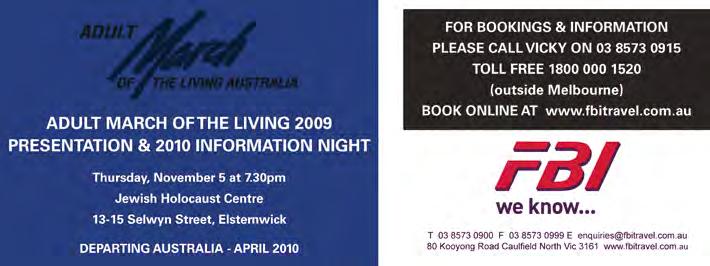
Simple, yet powerful pedagogic tools are the foundation for Project Zero. One tool is simply asking students, ‘What do you see? What do you think? What do you wonder?’ about a painting or photo. Another is to ask students, ‘What makes you say that?’ Another is ‘Think, Pair and Share’. That is, quietly think, pair up with someone else and share your thoughts. Whilst these may seem fairly obvious, they are nevertheless very powerful. Most important is to articulate ideas and then to record them for others to see and consider.
These tools are being increasingly used by our guides when taking school groups through the museum, and at the end of their visit in the reflections session. We actually tell students that we collect their thoughts, either on an easel that stands in the foyer, or in the visitors’ book, and that before they
leave they are welcome to write their thoughts and impressions. While these are written with their memories fresh in their minds, and we rarely ever see the students again, many of these recorded thoughts do, in fact, give us great cause for optimism and hope for the future. Here are just a few (and you will find more in the students’ own handwriting on the following page): Thank you so much for sharing your experience with us. You have changed lives today.
We learn for knowledge, but also for wisdom. We can learn from an experience such as this.
I’ve re-evaluated my life. Maybe I won’t waste my days. As the Talmud states, ‘When you teach your child, you teach your child’s child.’ Hopefully, the life lessons which these comments express will be passed on and the JHC’s mission statement will continue to be realised for generations to come.
Follow-up to my last column: You may recall I wrote about the proposed draft of the national history curriculum, and of concerns that many Jewish educators had with the way the Holocaust was conflated with the conflict between Israel and the Palestinians. Recent changes to the entire process of creating a national curriculum have been made and currently it appears that the Holocaust is not mentioned at all in the most recent documentation http:/www.acara. edu.au/default.asp. Again, I will keep you apprised of developments as I become aware of them.

EDUCATION JHC Centre News 16
* * *
Zvi Civins
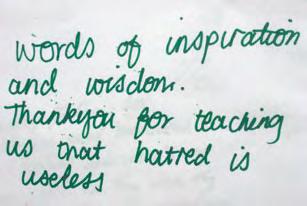
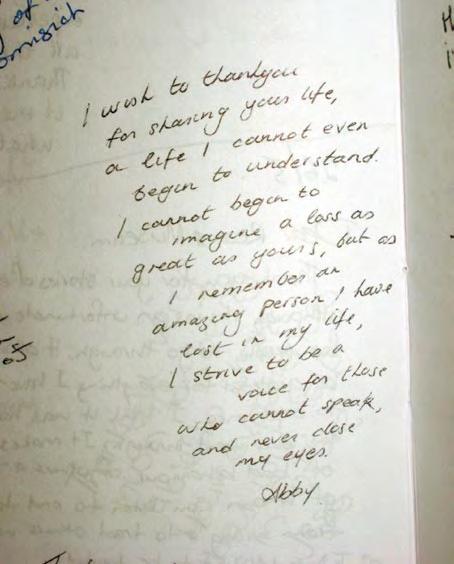
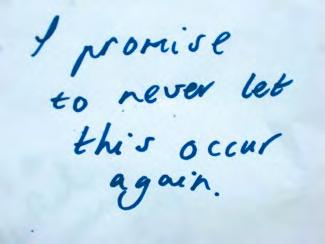
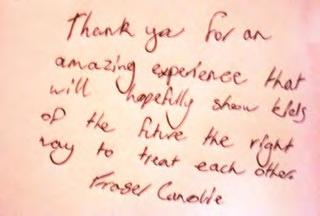
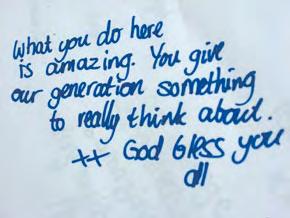
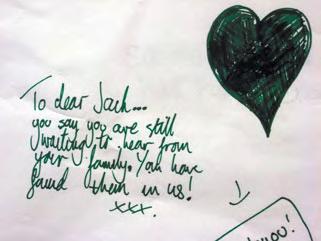
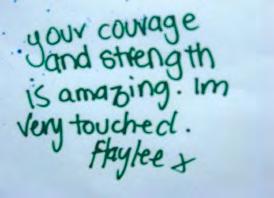

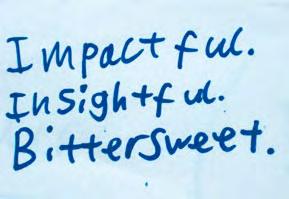
JHC Centre News 17
Student March 2009
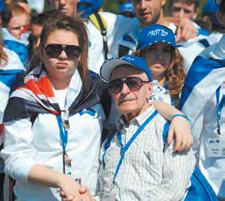
Travelling to Lodz was a particularly meaningful experience for me, as the city is the birthplace of my grandfather, David Prince. My grandmother, Judy Kolt, lived in a nearby town, but travelled to Lodz frequently as a young girl to visit her grandparents. I was privileged to travel to Poland with both David and Judy, my grandparents and courageous survivors, who gladly shared their lives with all participants.
For so many years I have heard the names of the streets, seen the old black and white photographs and a few newer additions from when my parents visited; but the accounts were yet to come to life.
On 24 April, our group walked along the narrow footpaths of inner city Lodz and reached 93 Pormorska, the

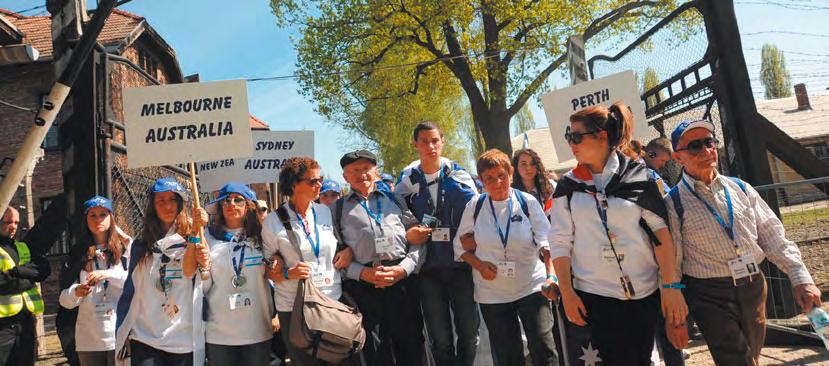
home of my grandmother Judy’s grandparents some seventy years ago. As Judy spoke inside the courtyard of the apartment complex, she pointed up at what was once her family’s home and we listened intently, seeking to imagine the Jewish life that once was.
We then made our way to 17 Procknika Street, previously Zawadska Street. This was the first home of my grandfather, David. As he spoke, my grandfather brought to life the childhood games he played and his memories of the sukkah on the balcony above. Shortly after, we stood at the site where the Voliner Synagogue once was. Nothing remained – no bricks, no mortar, not even a plaque. Nothing but my grandfather’s vivid description of what once was. We got a sense of what was lost through the pre-war photo of the synagogue which my grandfather proudly held as he spoke. This was his family shul. I stood by, absorbing every word; comparing the now empty block of land to the bustling Jewish life of the past.
We then moved on to Aleja 1 Meja, my grandfather’s home during the last three years before the war.
This journey to Lodz, a journey into the past, has given me a clearer insight into my family’s origin and way of life.
NOEY KOLT
Coming from the midst of despair, at 4:00 in the morning we finally arrived in Eretz Yisrael. Fighting back sleep and constant yawns, a group of 83 enthusiastic March of the Living participants clapped and sang as the plane touched down. At this moment there was a smile on everybody’s face, as the thought of being in Israel had been a key factor in keeping us sane during the heaviness of the past seven days in Poland. Now the time had come!
As varied as the land itself were our experiences in Israel. There were tears shed at Yad Vashem, as well as at a Yom Hazikaron tekes, a solemn ceremony dedicated to the fallen soldiers of Israel. From the wailing sirens to the joyful screams the mood suddenly shifted to celebration with the arrival of Yom Ha’atzmaut, Israel’s independence day. There was also much time for relaxing and bonding together as a group on Shabbat in Jerusalem, and at our nightly reflection meetings.
As strange as it was to go from such sadness to rejoicing, we all felt it was much needed. I found it comforting to think that the departed spirits we left in Poland would have rejoiced to see us here.
JHC Centre News 18
Commencement of March at Auschwitz
Noey Kolt, David Prince, Judy Kolt and Frances Prince at Majdanek
MARCH OF THE LIVING
Rachel Tigel and Abe Goldberg
Although we had left Poland, we had not left the Holocaust behind. A visit to the amazing Yad Vashem Museum was yet another step of our journey. We walked through the museum room by room to educate ourselves further on the history of the Shoah. Although we had seen many places whilst in Poland – Auschwitz, Majdanek and Belzec to name a few – there were still so many things that shocked us, that played on our emotions, and once again a sombre mood swept over the group.
We walked through the Valley of the Communities, a maze consisting of the names of shtetls and cities which had once been home to vibrant Jewish life. We stood in a haunting room dedicated to the one and a half million murdered children, where just a few candles are reflected by mirrors to give the image of thousands of flames. We then gathered under a dome surrounded by what seemed like endless bookshelves carrying three million names of the murdered, but
I saw them pile in, naked and bare But all I could do was stand and stare Trembling with fear and engulfed in the unknown Lies and betrayal were all that they were shown They scrambled about in absolute confusion They obeyed the orders as they did in the Nazi intrusion
The heavy door was then shut and locked Their faces turned from confused to shocked
The internal scream within their eyes
Makes me realise it’s too late to apologise
The gas poured in quick and sly
I hear the families and children start to cry
Before they pass a father whispers to his son ‘Be brave and strong’
International
Adult March 2009
This was my sixth time in Poland, leading my fifth adult group, and words do not adequately capture the impact and the depths of this emotionally charged journey. We certainly were a very special group, thrown together in close confines and confronted with the horrific events of the Holocaust, the incongruence of Poland and then Israel. As we trod the landscape, we grew close knit. We shared some heartfelt times, and some challenging ones too. It was truly wonderful working with our guides, Chaim in Poland and Lior in Israel.
In Poland we were 47 participants on one bus; in Israel we were 30. We ranged in age from 20 to 85 years. We came from Johannesburg, Pretoria, Melbourne, Sydney, Brisbane, Los Angeles, San Diego, Tucson, Miami, Philadelphia, New York, Montreal and Toronto. We were three generations travelling together – father and daughter, mother and son, mother and daughter, husband and wife, father and sons, sisters, aunt and niece, and we bonded!
A highlight of the journey was meeting with the Righteous Among the Nations. We were privileged to hear from Anna Bando, Alicia Szezpzniek-Schnepf and Jozef Walaszczyk. They had just returned from the USA where they had met with President Obama.

nothing to me was as moving as my exit from Yad Vashem.
Walking outside, I was confronted with a beautiful view over Jerusalem. My heart leapt with exhilaration realising what the landscape I was gazing at means to the Jewish people. A sense of security swept over me as I felt that as long as Israel exists, our future as the Jewish nation is secured. My journey from the darkness had finally turned to light.
AIMEE LEWIS
How many people have to die before humanity realises murder is wrong?
I watched them scream as they churned Within minutes, silent they turned The door then reopens, a man stands ahead Making sure everyone is truly dead Nazis made the Jews pay their tolls With which they payed with their innocent souls
Everywhere there are blue stains
Along with the victims silent pains
I am the only witness in which I watched them fall Being here in the gas chamber, as a wall.
CODY TONKIN
I am forever humbled in their presence. ‘How could you call us “good”?’ they say. ‘We were doing what had to be done. We did not do anything special.’ That is the question of the righteous – those who did extraordinary good at extraordinary risk, not for affirmation or acclaim or to advance their own interests. They are a powerful reminder that no one is born a saviour or a murderer – we each have the power to make these choices.
Phil Balch, a participant from Tucson, Arizona reflected:
This has been the most extraordinary two weeks of my life. It has been one week since I returned from Israel, and two weeks since leaving Poland. Here’s what I know: The impact of the trip has surely not been digested and is carried around with me as part of my soul; I feel obligated to do more to embrace those who are victims and find a way to be more tolerant of the world around us; it is incredibly important to bear witness to what happened to our people …
JHC Centre News 19
Australian adult group at Auschwitz 1 before the March
Pauline Rockman
A Personal Reflection
Roth
Yom Hashoah at the Centre
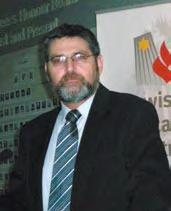
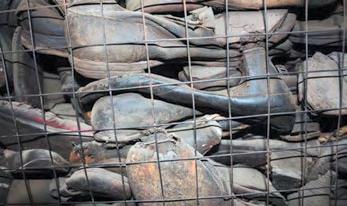

It was more the unexpected than the expected that leaves the greatest memory of my trip to Poland. There were two such occasions for me.
First, when we went to the site of the Treblinka death camp, I was struck by how powerful the memorial was, given its simplicity. Even though, unlike Majdanek, there were no remains of the camp, the vast numbers of stylised tombstones were a powerful reminder of the devastation that took place there. While walking amongst the ‘tombstones’, every so often there was the name of a Polish town embossed in black on the stone. None were familiar to me until I came across Makov Maz. Could it be my late father-in-law’s town? I wasn’t sure because as far as I was aware his town’s name was simply Makov. I called my wife in Melbourne and she confirmed the town was in fact Makov Masziewsk. It was his town. I was overtaken by emotion. It was as though I had paid my respects to, and acknowledged the pain of my father-in-law, the late Sam Gromb, who suffered indescribably at the hands of the Nazis. Next, when touring the Majdanek death camp, we entered a large barracks. I was taken aback by the thousands of pairs of shoes. Each pair of shoes was that of a victim of murder. If all the shoes of all the victims were to be displayed, there would be 80,000 pairs of shoes. Wandering around the barrack in disbelief I stopped at one of the wire cages which held the shoes. It dawned on me that, unlike all the other exhibits of shoes, hair and spectacles we had visited, we could actually touch these shoes. I respectfully reached into the cage and touched a single shoe. It was this ability to touch the shoe of a victim which brought a new dimension of connectedness that I had not felt before. With my eyes shut and feeling enormous pain I said to the victim, ‘I am so sorry for what happened to you in this ghastly place.’

On April 21, the Centre commemorated Yom Hashoah through an intimate and reflective program. As a continuation of the previous evening’s commemoration by the Jewish community Council of Victoria (JCCV) held at Monash University, the Centre offered a further opportunity for the survivor community, their families, Jewish day school students and the general public to participate in an afternoon program. This allowed people a chance to pause and remember the Holocaust as an end-of-day commemoration.
The program included an introduction by Education Director, Zvi Civins, who outlined the significance of the day. Helen Leperere, Holocaust survivor and active Centre volunteer, gave a poignant address about the significance of Yom Hashoah to her, the impact of memory and the effect of the Holocaust, not only on survivors, but on the second and third generations. Rabbi Ehud Bandel, from Kehilat Nitzan followed, sharing personal recollections of growing up as the child of a Holocaust survivor. Rabbi Bandel then recited El Maleh Harachamim (the prayer for the soul of the departed) and six commemorative candles were lit by Holocaust survivors and the younger generations. The afternoon concluded with a musical program in Yiddish, Hebrew and English presented by the Sholem Aleichem choir.
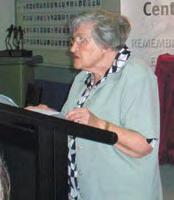
JHC Centre News 20
EVENTS
Sholem Aleichem School Year 6 choir
Trevor
Trevor Roth
Some of the 80,000 pairs of victims’ shoes on display at Majdanek
Helen Leperere
Rabbi Ehud Bandel
Testifying to the Holocaust Book Launch
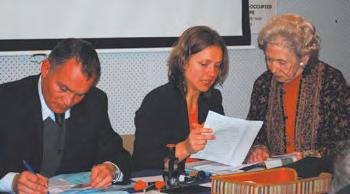
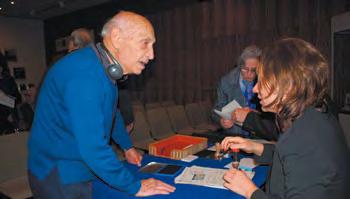
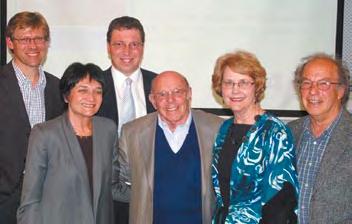
On Yom Hashoah we reflect on the nightmare of the Holocaust and 21 April 2009 was a fitting day for the Centre to launch a book of essays exploring the phenomenon of Holocaust testimony, particularly related to the Jewish Holocaust Centre Collection.
One of the book’s editors and contributors, Associate Professor Michele Langfield, opened the proceedings. Langfield and her colleague Pam Maclean have been driving forces behind the collaboration between Deakin University’s History Department and the JHC Video Testimonies Project. This has seen numerous Deakin students undertake research utilising the JHC’s unique oral history collection.
The keynote speaker at the book launch was Professor Alistair Thomson from the School of Historical Studies at Monash University, himself a leading academic working in the oral history field. Thomson delivered an excellent
appraisal of the essays, noting how important this book is to students of both Holocaust history and oral history. Prof Thomson discussed the issues surrounding oral testimony and the inadequacies of memory and commended the book for its honest discussion of these vital questions. Dr Tony Barta then spoke about the importance of the JHC Testimonies Project and the work carried out by Phillip Maisel, OAM and all the survivors who have come to give their eyewitness accounts. He recalled how he first came to the Centre almost twenty-five years ago with his university students, whose project was to film an interview with a survivor. This project achieved two noteworthy outcomes: first, it planted the seed of an idea with the survivors at the Centre that blossomed into the Testimonies Department, but just as importantly, each of these students was deeply touched by the experience of filming survivor testimony. Finally we heard from Dr Dvir Abramovich, Director of Melbourne University’s Centre for Jewish History and Culture. Dr Abramovich is also President of the Australian Association of Jewish Studies, the publishers of Testifying to the Holocaust. Abramovich stressed the book’s importance in the current climate where racism and anti-Semitism are on the rise, a theme that carries through many of the opinion pieces he writes for the media. He emphasised the value of the JHC survivor testimony collection in the face of the numerous Holocaust deniers that spread their lies today.
Throughout the night the efforts of Phillip Maisel and his team of volunteers was justly praised, as was the bravery of the survivors who have made the supreme effort to give their testimony. The essays written in this book allude to the next important phase in the life of this collection – the possibilities it opens up for researchers for generations to come to view and study these testimonies. As Dr Tony Barta put it, it enables future generations to encounter survivors, not in real life but face-to-face nonetheless – the next best thing.
Life Certificates Issued at JHC
For the first time, the German Government issued Life Certificates to Holocaust survivors seeking repatriation from the German government at the Holocaust Centre. Held annually, this event has always taken place at the German Embassy in South Yarra, but on 8 July this year it was held in the Centre’s Marejn Auditorium. Vice Consul Katrin Wünsch and her consular colleague Wolfgang Klapproth answered queries and
endorsed documents for around 65 people who came with their official papers from various German authorities.
Initiated by Elly Brooks, President of the Friends of the Holocaust Centre, and Dr Anna Marie Shleich, German Consul General for Melbourne, survivors were able to make an appointment to have papers signed at the Centre. The issuing of Life Certificates will now become an annual event in the Centre’s calendar.
JHC Centre News 21
(l-r) Rear: Prof Alistair Thomson, Dr Dvir Abramovich, Front: Pam Maclean, Phillip Maisel OAM, Assoc Prof Michele Langfield, Dr Tony Barta
Max Zajac receives his certificate endorsement
Wolfgang Klapproth and Katrin Wünsch help a survivor prepare her documents for signing
Third Seder for Holocaust Survivors
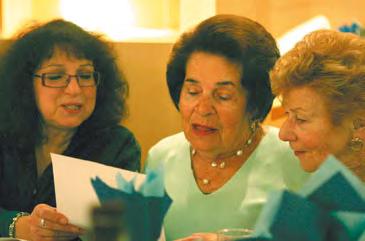
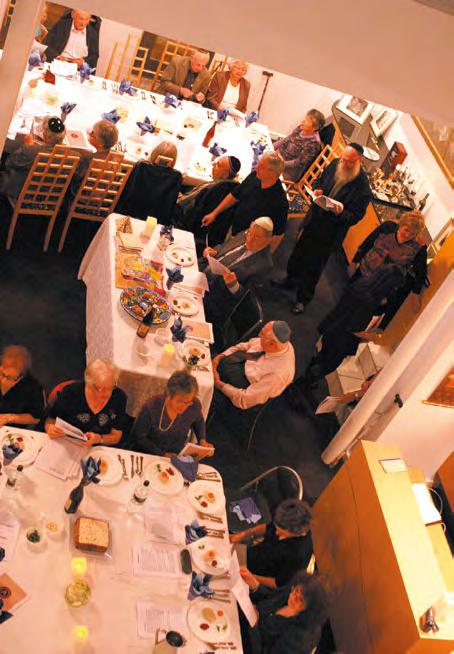
Amemorable third seder, conducted by Education Director Zvi Civins, was a highlight of the Centre’s 25 years calendar. The seder was designed as a re-enactment of the 1946 Passover seder in Munich, the first held after the liberation, as recounted in the Survivors’ Haggadah by Saul Touster. Centre guide and Friends committee member Sue Lewis, together with her husband Phil, generously provided their home for the evening – the perfect setting for the seder.
Sponsored by the Friends of the JHC, the non-traditional seder and dinner honoured the many dedicated Holocaust survivors associated with the Centre over the past 25 years. Over seventy people attended, many of whom had not come together for many years. They included founding
members, retired guides and volunteers, some of whom were present at the original 1946/47 sedarim in Munich.
Survivors were invited to speak about their recollections of their first seder after liberation, wherever it may have been. They reflected on the meaning of Passover in their lives as survivors, new immigrants and free Australians. Remarkable and amusing stories of kindness, friendship and life in a new culture were recounted with emotion by so many.
Reflecting the impact of the seder for him, Shmuel Rosenkranz, past President of the Holocaust Centre, praised Zvi Civins. ‘The seder was a unique and unforgettable experience, one that shifted the focus of Pesach from Egypt, slavery and Israel to the true understanding of freedom in the context of the Holocaust and liberation,’ he said. Shmuel’s highlight was the impromptu singing of the Partisan’s Song at the seder’s end. It was an upllifting and appropriate conclusion to a wonderful evening, affirming the strong bond between everyone who took part.
 Looking down at the seder at the home of Sue and Phil Lewis
Looking down at the seder at the home of Sue and Phil Lewis
JHC Centre News 22
The Survivors’ Haggadah
Cheryl Korbman, Rosa Krakowski and Halina Zylberman
Open Day at JHC
Testimony at the Jewish Holocaust Centre
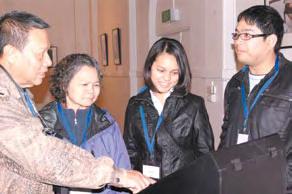
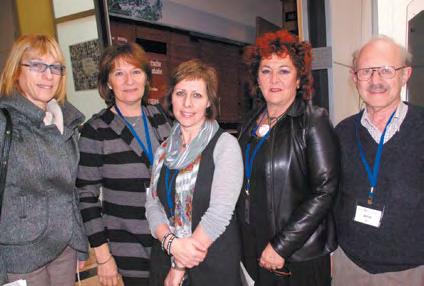
With the release of the Hollywood blockbuster movie Defiance, which features the heroic story of the partisan Bielski brothers, Zelda Bielski-Belkin has come forward to tell of her role in the events featured in the movie. Now aged 89, Zelda is a cousin of the Bielski brothers. After escaping from the Nowogrodek Ghetto as a young girl during World War II, she trained as a partisan with her cousins in the surrounding Polish forests.
As part of the 25 year celebrations throughout 2009, the Centre held its Open Day on Sunday 14 June. The afternoon was devoted to showcasing the Centre’s exciting programs and the people who are responsible for making them happen. Activities on the day included the launch of the Centre’s innovative StoryPod technology, Dr. Abhijit Chattaraj’s ‘Whispers in the Wind’ photographic exhibition, talks by the professional teams who work at the Centre and a glimpse of the plans for the museum upgrade, scheduled to commence in December.
It was also an opportunity for the public to be guided through the museum by Holocaust survivors, and to hear first-hand accounts of their experiences and the relevance of these experiences to today’s world. Over 250 people attended, including VIPs Helen Whiteside, Mayor of the City of Glen Eira, Judith Klepner, Deputy Mayor of the City of Port Philip, Tony Lupton, Member for Prahran, Negba WeissDolev, President, Jewish Museum of Australia, local residents and members of the Jewish community.
The prototype StoryPod was a highlight on display in the Centre’s foyer, before being moved into the museum where it will be housed permanently. The ‘Whispers in the Wind’ photographic exhibition is open until early October.
Feedback from visitors summed up the day. One said: ‘The vibe was lively, warm and inviting’ and a second: ‘The information the JHC delivered was meaningful, interesting and relevant.’
Zelda has told her story in Polish, Yiddish and Russian, with her three daughters, Ludmilla Yukilis and twins Nina and Svetlana Bielski, acting as English interpreters. Fuelled by the need to tell her story before it is forgotten and the recent interest evoked by Defiance, Zelda has now completed her audiovisual testimony, a valued link to the many other partisan stories in the Jewish Holocaust Centre collection.
Phillip Maisel, recipient of an Order of Australia Medal for his work in this area, has filmed Zelda’s story, which is a rich addition to the over 1300 Holocaust testimonies still being filmed, stored and preserved at the Centre. Several other significant testimonies have been received over the past few months, despite the passage of time since the Holocaust, as survivors feel the sense of urgency to record their recollections before their capacity to remember diminishes.
Individual testimonies are still actively being sought from Holocaust survivors. For a confidential discussion and interview, contact Phillip Maisel at the Jewish Holocaust Centre on 9528 1985.
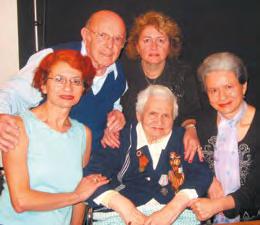 Elly Brooks, Helen Mahemoff, Frankie Pinch, Pauline Rockman and Lionel Sharp
StoryPod IT consultants and RMIT graduates (Nat) Buddhiporn Palakawong Na Ayudhaya (centre) and Aukrit Chadagorn (right), with Nat’s parents
Elly Brooks, Helen Mahemoff, Frankie Pinch, Pauline Rockman and Lionel Sharp
StoryPod IT consultants and RMIT graduates (Nat) Buddhiporn Palakawong Na Ayudhaya (centre) and Aukrit Chadagorn (right), with Nat’s parents
JHC Centre News 23
Zelda Bielski-Belkin, centre, with (from left), Nina Bielski, Phillip Maisel OAM, Ludmilla Yukilis and Svetlana Bielski
Another Valued
HOLAGIF 09: Holocaust and Genocide International Film Event
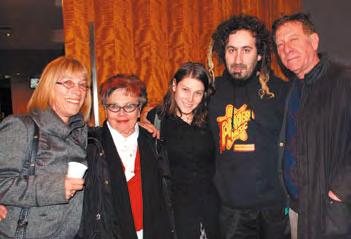
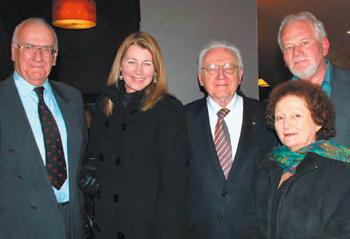
In a first for Melbourne, the Jewish Holocaust Centre presented HOLAGIF 09 – the Holocaust and Genocide International Film Event. The event took place from August 9–12 and screened fourteen films from seven countries over four days, with daytime sessions at the Jewish Holocaust Centre and evening sessions at the Classic Cinema. Its aims were to highlight current noncommercial films that have been made about the Holocaust and bring awareness to the realities of modern genocides and human rights stories from around the globe.
Adele’s Wish (USA 2008), directed by Terrence Turner, documents 93-yearold Maria Altmann’s remarkable battle against the Austrian government for the return of five of renowned artist Gustav Klimt’s paintings, some featuring her aunt Adele Bloch Bauer, that were stolen from her family after the Anschluss in 1938 in Vienna.
Pray the Devil Back to Hell (USA 2008), directed by Gini Reticker, is a documentary which traces the struggle that unites the Christian and Muslim women of Liberia to triumph over the corruption and greed of their countrymen and the civil-war torn conditions in which they and their children are forced to live.
L’Affaire Finaly: Hidden Children (France 2008), directed by Fabrice Genestal, is a film based on the true story of Jewish children Robert and Gerald Finaly, whose parents, fearing deportation to the death camps, leave them in the care of a devout Catholic woman in Nazi-occupied France. After the war, the brothers’ surviving relatives struggle to regain custody of them, exposing the fraught relationship between the Catholic Church and the Jews.
HOLAGIF 09 was one of the featured events of the Centre’s 25 years celebrations. It arose out of the great interest in Glimpses, the Centre’s 2007 day of film, together with the burgeoning growth of films related to the Holocaust over the past five to seven years.
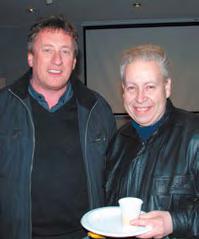

HOLAGIF 09 screened films that were powerful, moving, profound and uplifting and featured the Australian premiere of several films.
Po-Lin Slivers of Memory (Poland 2008), directed by Jolanta Dylewska, was the opening film of HOLAGIF. It depicts the lively and vital Jewish communities of 1930s Poland reconstructed for the first time using amateur film footage, depicting a time when the Jewish and Polish cultures existed side by side.
Yodok Stories (Norway 2008), directed by Andrzej Fidyk. Yodok is a North Korean concentration camp that secretly exists today and operates as a barbaric system of torture, starvation and murder. The film explores a small group of survivors who escape to the South and express their horrific experiences through the creation of a musical production.
George and Denise Luk-Kozika, Christopher Lancucki, Eti and Izi Marmur
Elly Brooks, Eva Presser, Debbie Cohen, Bram and Dan Presser
Zvi Civins, Helen Mahemoff and Julian Silverman
JHC Centre News 24
Sean Meltzer and Peter Krausz
Photos: Ziva Fain
Club JHC Katy Meltzer
Just over twelve months ago, a new fortnightly social group for retired guides and other volunteers began at the Jewish Holocaust Centre. The ‘Thursday Group’ enables retired guides to stay connected with each other and with the Centre. The group is coordinated by Katy Meltzer, with the support of Max Wald, Barbara Sacks and Lynne Flax. There is no cost to the participants, as the group is funded by various grants and donations.

The group provides a varied program of activities. Group members have the opportunity to catch up and shmooze, participate in stimulating discussions, listen to interesting speakers, go on excursions, exercise, and always, to enjoy a good joke and a delicious, healthy lunch. This year we have continued our ‘Healthy Ageing’ series by having speakers discuss how to sleep better without drugs, and how to avoid falls at home. We have also had an interesting tour of the Heide Art Gallery and a fun excursion to see the movie Max and Mary. Thoughtprovoking sessions were led by Rabbi Fred Morgan, who discussed the current status of interfaith relations in Australia; Professor Andrew Markus, who discussed
Club JHC at Heide Gallery
issues relating to Jewish demographics in Australia; and Adele Hulse who spoke about her journey into Buddhism. Zvi Civins and Tomi Kalinski each gave wonderfully entertaining and interesting talks, about Purim and Yiddish theatre in Melbourne respectively. Individual group members have also volunteered to lead sessions by presenting their own favourite pieces of music or literature to the rest of the group in our new ‘Desert Island Discs’ segments.
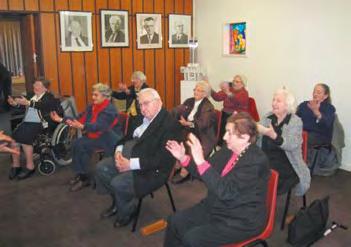
Established initially for retired guides, the success of the group has recently led us to widen our list of invited participants to include older, current guides and other former volunteers who are available on alternate Thursdays. If you are interested to join our group or to support it financially with a tax deductible donation, please contact Lena Fiszman at the Centre on 9528 1985.
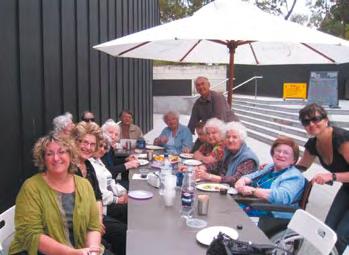
Saba Feniger Receives Multicultural Commission Award
Mrs Saba Feniger, first Jewish Holocaust Centre Curator, received the Victorian Multicultural Commission (VMC) Victorian Refugee Recognition Record (VRRR) at a VMC awards ceremony on 17 June 2009.
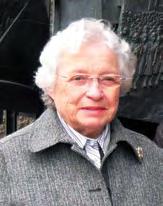
Saba, nominated by the Centre’s Head of Collections, Jayne Josem, was recognised for the enormous contribution she made during her seventeen years of voluntary service at the Centre. From 1984, soon after the Centre opened, Saba was a guide and active contributor to both the permanent and temporary exhibitions held at the Centre. From 1989 onwards, she took on the role of honorary curator, curating fourteen temporary historical exhibitions and six art exhibitions, whilst maintaining and updating the existing permanent display. She was also a key administrator, public relations co-ordinator and spokesperson for the Holocaust Centre in its formative years.
Saba has written her memoirs, Long Memories, Short Stories, as well as numerous poems, and is still an inspiring contributor to the JHC. Saba was presented her award by the Victorian Multicultural Commission Chairperson, Mr George Lekakis, at a formal awards reception.
25 JHC Centre News
Adele Hulse discusses her journey into Buddhism
Israeli chair dancing at JHC
Saba Feniger
A Win-Win for AJAX Football Club and JHC

When Brian Goldberg became president of Ajax Football Club at the beginning of 2008, he wanted to give the players more of a sense of the club’s uniqueness. It was a well run and successful club but Brian wanted to encourage players to be more motivated as a team and to contribute to the club. Stories about club history and traditions are an important part of any club, and these are usually transmitted from father to son. However, AJAX was only established in 1957 and most current players are the first generation of their families to play Australian Rules Football. As a relatively new club, Brian looked to what was special about AJAX. He felt that there was no higher value reason for the existence of a Jewish football club than the Jewish survival story, so for him, the Jewish Holocaust Centre was the logical place to start. So began an unlikely relationship between a football club and a Holocaust centre which has been very positive for everyone involved.
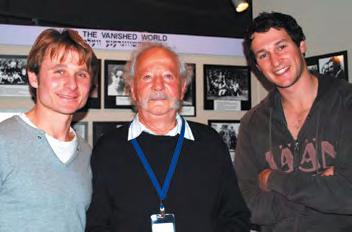
The players have been very supportive of JHC and this year the club decided unanimously to continue its relationship. However, players wanted to do more to spread the Centre’s message. As a result, the JHC logo is now on the AJAX website, and there is information about the Centre in the AJAX clubrooms, as well as in an online email that goes to 1000 people.
Apart from providing players with a greater sense of where they come from, the message of preventing racism and fostering understanding has gone beyond the AJAX clubrooms. Recently another club contacted AJAX after a player alleged that he had been racially abused. This club felt it may have to pursue legal action, but before doing so, an approach was made with AJAX to see whether there were any other alternatives. As a result, AJAX offered to arrange for the alleged discriminator to come to the JHC. It was to be an anonymous visit for one hour, to hear a survivor’s story, and the visit was to be followed up by an apology to the alleged victim. A time has been set and if this process is successful, it could avert more confrontational legal action and provide a model for other clubs.
The enthusiasm of AJAX committee members, coaches and players for the special relationship with JHC is a sign of its success as a motivational tool. After the club’s visits to the Centre both last year and this year, AJAX won their following two games. While this is not exactly hard-core statistical evidence, perhaps it’s no accident either!
JHC would welcome other organisations wishing to establish a similar relationship with the Centre. For further information, please contact Nicole Brittain, Development Manager on 9528 1985.
Brian’s suggestion to nominate the Jewish Holocaust Centre as the AJAX club charity received encouragement and support from the committee and players right from the start. The first step was a visit by the committee, coaches and players – seniors, reserves and under 19s – to the Centre. The visit took place at 10:00am on a Sunday morning, and even after a big party the night before, sixty of the total of over eighty people attended.
Club members were shown around the museum by survivor guides Willy Lermer and Halina Zylberman. The message of the survival story made a deep impression on everyone who took part and a second visit was arranged at the beginning of this year’s season. After both visits an envelope was passed around and the proceeds presented to the Centre.
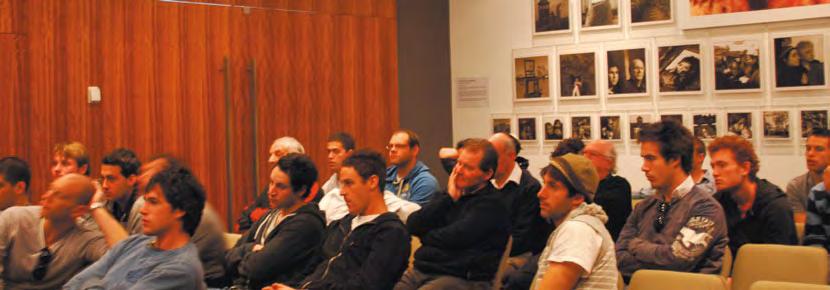
JHC Centre News 26
AJAX Football Club players learn about the Holocaust during their visit, July 2009
(l-r) Brian Goldberg, President AJAX Football Club, Henri Korn, JHC guide, and AJAX player Ben Hershan
AJAX Football Club in action
Bequest Program
Gains Fresh Focus with Appointment of JHC’s New Development Manager
educate students for many, many years to come; and helping us to continue to plan for our future,’ she said.
The Jewish Holocaust Centre is delighted to welcome Nicole Brittain, our new Development Manager. In her twelfth year in fundraising and development in the not-for-profit sector, Nicole previously worked at the Make-A-Wish Foundation, Vision Australia and Mind (Richmond Fellowship). The grandchild of a Holocaust survivor, working at the Centre has special meaning for her. An added bonus is the convenience, as she lives locally and has two young children at Sholem Aleichem School.
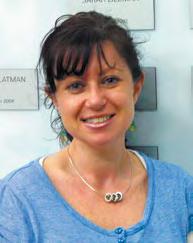
Nicole has taken over the administration of the Centre’s Bequest Program, which has been running successfully for a number of years. ‘We are very proud of the bequest program,’ said Nicole. ‘Our most notable bequest has enabled the Centre to establish the Nona Lee Education Program, the Centre’s school education program. This has enabled more than 400,000 secondary school students to attend educational tours and programs run by the Centre since its inception.’
The Nona Lee Educational Program includes:
• An introduction to the Holocaust
• A brief documentary
• A Survivor testimony
• A guided tour of the museum displays
• Reflection and farewell
• An opportunity to light a candle in the Memorial Room
Over the years, the Bequest Program has been popular and the Centre has received considerable support. As the Centre does not receive any on-going government funding, the bequests, both large and small, have contributed significantly to the Centre’s work and have enabled the Centre to fulfil its mission of keeping alive the memory of victims of the Holocaust, combating anti-Semitism, racism and prejudice, and fostering understanding in the community.
Nicole urges the Centre’s loyal friends, volunteers and supporters to think about the JHC when making their wills. ‘This is one way of making a positive difference beyond your lifetime; keeping the memory alive; continuing to
JHC knows that making a will is a very important part of planning for the future, and that providing for loved ones first and foremost is important. Once this is done, however, Nicole invites you to consider including the Centre as a beneficiary.
She points out that you can make a bequest to the JHC in a number of ways. You may choose to:
• Allocate a specific amount of money, items or property to the JHC
• Nominate the JHC as a beneficiary to your insurance policy
• Establish a trust fund where the interest earned is donated to the JHC or
• Designate the residual or a percentage of the residual of your estate to the JHC
Whilst the Centre understands that making a Will is a very personal matter, it would be a great help if you do intend making the Centre one of your beneficiaries, or have already done so, to let Nicole know.
As well as helping JCH plan for the future, it gives us an opportunity to acknowledge and recognise your generosity and to discuss with you how you wish your bequest to support the Centre. You may choose to support the Education Program, the Testimonies Department or the Archives Department. Alternatively, you may wish for us to decide how to best allocate your funding or you may wish to make your gift in perpetuity, to be administered by the Foundation. Any information will, of course, be in the strictest of confidence.
If you know of a friend or a loved one who has made a bequest to the JHC, Nicole would be delighted to show you the Bequest Honour Board. This honour board, on display at the Centre, has been established to recognise all our bequestors in perpetuity.
To organise a confidential discussion about making a bequest, to obtain a Bequest Brochure or to inform us of your plans, please contact Nicole Brittain, Development Manager of the Jewish Holocaust Centre, on 9528 1985 or nicoleb@jhc.org.au
Would you like to become a volunteer at the Jewish Holocaust Centre?
Volunteers are the lifeblood of our Centre. The Centre has around 160 volunteers – 70 who do a myriad of tasks, playing a vital role in all facets of the Centre’s work, and almost 90 trained volunteer museum guides. Volunteers are involved in office administration support, reception, updating the database, IT support, assisting with organising events and working with a group of retired survivor guides and volunteers.
Volunteers come to the Centre weekly, fortnightly or monthly, or whenever they can. If you have any time to volunteer and feel that you can contribute to the Centre, Rae Silverstein, the Centre’s Volunteer Co-ordinator, would love to hear from you.
You can email her at rmsilverstein@optusnet.com.au or phone her on 0408 575 477, or at the Centre on 9528 1985 (only on Tuesdays).
JHC Centre News 27
Nicole Brittain
Friends of the Jewish Holocaust Centre
Elly Brooks
The Friends of the Jewish Holocaust Centre continues to grow and support the Centre through membership subscriptions, raffle book sales, sales of the Entertainment Book and social fundraising functions. As well as supporting the Centre financially, we also provide personnel to assist Centre staff whenever possible. With Friends’ support, the Centre has been able to purchase a new database management system which will allow staff to effectively maintain all records and increase membership and donations.
Our hard-working and dedicated committee meets monthly at the Centre. Thank-you to committee members Adam Kreuzer, Alice Peer, Anita Bartfeld (Young Friends), Annette Hayman, Caroline Bryce, Elly Brooks, Hannah Fagenblat, Judy Goldman, Kathy Janovic, Lulek Bron, Rebecca Davis, Rosi Meltzer, Silvana Layton, Sue Benkel, Sue Lewis, Susie Kleid and Susan Onas.
As part of the Centre’s 25th anniversary celebrations, Friends hosted a 3rd Seder in April, at the home of Sue and Phil Lewis to honour our survivor volunteers. You can read more about this wonderful evening on page 22 of this Centre News. We had a sell-out for both Lara Sacher’s highly acclaimed play I Can Cry at the Malthouse Theatre and Rachel Berger’s play Hold the Pickle at Chapel on Chapel. In June we also had a musical recital by the Hamer Quartet at the West Brighton Club where a large gathering enjoyed the club’s beautiful surroundings and a preview of the quartet’s repertoire, which has since won international acclaim.
On 6 December, the Friends will hold a fundraising art auction under the guidance of our art consultant, Norman Rosenblatt. This event could not take place without the efforts of our Art Auction Committee, and we thank committee members Elly Brooks, Hannah Fagenblat, Kathy Janovic, Susie Kleid, Silvana Layton, Sue Lewis, Rosie Meltzer and Norman Rosenblatt. We are also grateful to Bonhams and Goodman who have sponsored this event. You will find details of the auction on the following page. We continue to support The Young Friends, as well as participating in the up and coming events of this 25th anniversary year.
If you would like to join Friends, please contact President Elly Brooks on 0409 002 485.
Help support the activities of the Centre by becoming a Friend
Cheque payable to: Friends of the Jewish Holocaust Centre
JHC Centre News 28
F R IENDS O F T HE J E WISH H O LOCA u S T C E NTRE M E MBERSHIP A P PLICATION F O RM (2009—2010) Title _____ First Name ________________________________ Surname ______________________________________________ Address ____________________________________________________________________________________ postcode __________ Daytime Contact Number __________________________ Mobile __________________________ E-mail ___________________________________________
Credit
Card No: Expiry Date: ________ /________ Cardholder Name: _________________________________________________________ Signature: ________________________________________________________________ $25 Single $45 Family $15 Single Concession $ ________________ Tick here for Young Friends (under 35) $ ________________ DONATION (All donations over $2 are tax deductible) $ ________________ TOTAL AMOuNT $ ________________ Please send payment to: Friends of the Jewish Holocaust Centre 13-15 Selwyn Street, Elsternwick 3185 Telephone: 9528 1985 Fax: 9528 3758
Website:
PAYMENT DETAILS FRIENDS ANNuAL MEMBERSHIP FRIENDS
Friends of the Jewish Holocaust Centre
Card: Visa Mastercard Diners Amex
Email: friends@jhc.org.au
www.jhc.org.au
To Life: JHC Friends Art Auction
6 December 2009
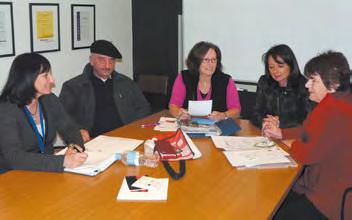
JHC Friends are pleased to host ‘To Life’, an Art Auction on Sunday 6 December 2009. This is part of the Friends’ pledge to raise significant funds during the Centre’s 25th anniversary year to support the upgrade of the permanent museum display.
The prestigious art auction house Bonhams & Goodman has very kindly offered to sponsor this event by conducting the auction and providing us with their magnificent venue at Level 1, 540 Malvern Road, Prahran. We are also privileged to have art consultant Norman Rosenblatt to assist us to source significant works.
For the auction we have sourced artworks from some highly recognised artists including Bruce Bellman, Joseph Brown AO, Rachel Boymal, Esther Ehrlich, Tom Fantl,
Eleonor Hart, John Howley, Rhys Lee, Victor Mazjner, Izi Marmur, Daniel Moyniham, Rosi Meltzer, Justin O’Brien, Sonia Payes, Marcus Rose, Tom Samek, Emmanuel Santos, Nicole Stein, Fred Williams and Mina Young. All works will be listed in a catalogue which will be available before and at the art auction.
We invite you to help us celebrate the Centre’s 25 Year milestone by attending the ‘To Life’ Art Auction. Please contact Tosca Birnbaum at JHC on 9528 1985 during business hours to be included on the mailing list for your invitation.
We look forward to seeing you at this wonderful event.
Proof of identity for recipients of German restitution/compensation payments
If you receive German restitution/compensation payments, the German Government has changed the procedures relating to proving who you are.
The new process is as follows:
1 Once a year you will receive a ‘life certificate’ from your German pension authority.
2 You must fill in this document and sign it.
3 You must also possess a valid current document with your photo on it, such as a driver’s licence or passport. If you do not have such photo ID, you can obtain a Victorian Proof of Age Card instead. If you need further information about applying for the Proof of Age Card, please phone Lena Fiszman at the Jewish Holocaust Centre on 9528 1985.
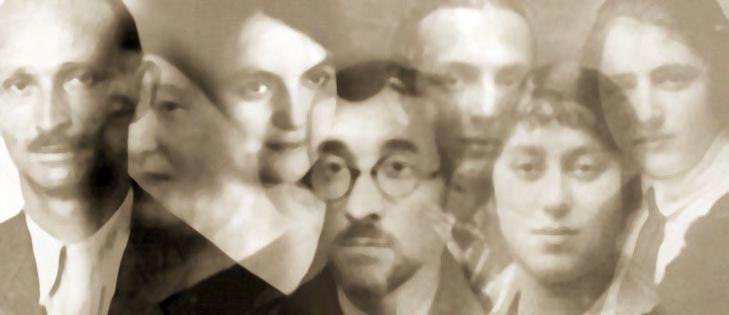
4 You must take the life certificate and photo ID document to one of the following authorities:
• German Consulate: The consulate will certify the life certificate and you must then forward it to the relevant German pension authority.
• A Rabbi, bank, local council or police: After it is certified, you should mail it to the German Consulate, which will then forward it to the relevant German pension authority.
If you are unable to sign due to illness, a medical certificate issued by your GP is required in addition to the certified life certificate.
If you have any questions, please call the German Consulate on 03 9864 6888.
miss the chance to become a Partner in Remembrance through the Jewish Holocaust Centre Foundation to ensure the on-going success of JHC.
Three levels are available and are payable over five years. All donations are fully tax deductible
Gold Partner $18,000 Silver Partner $10,000 Bronze Partner $5,000 Each ‘Partner in Remembrance’ will be acknowledged.
Further details are available from Helen Mahemoff, Chair of the Foundation
t: 9822 8080 or 0417 323 595
JHC Centre News 29
Don’t
Art auction organising commitee hard at work
FRIENDS
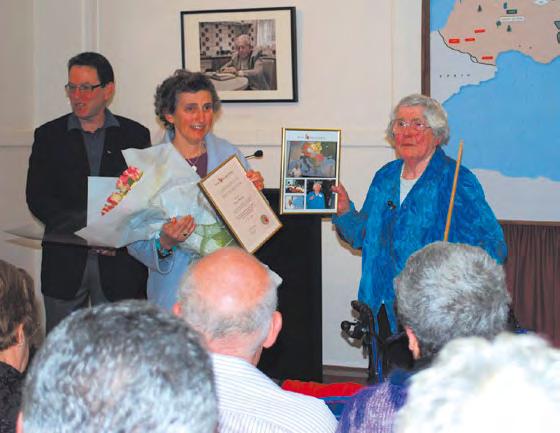
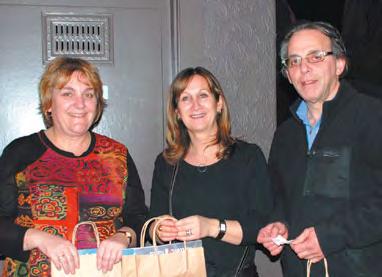

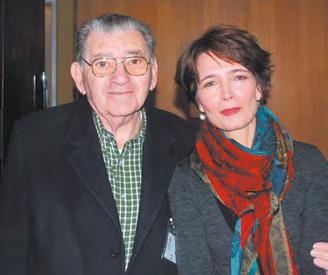

JHC Centre News 30 SEEN AROUND THE CENTRE
Pearl Recht receives recognition for 22 years of service as a guide at JHC
Alice Peer, Rosi Meltzer and Michael Goldberg
Jana Wendt, pictured with Willy Lermer, visiting the Centre to do research for her upcoming book
l-r Bernard Korbman, Jayne Josem, Robert Westheimer and Pauline Rockman with artwork by Harry Berkefeld painted while imprisoned in Gurs Camp in France, the birthplace of Robert’s late wife Evelyne
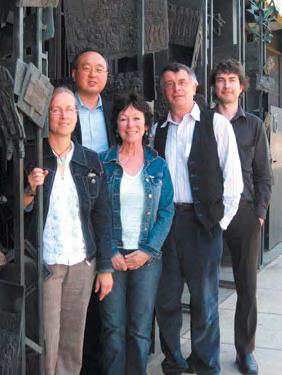
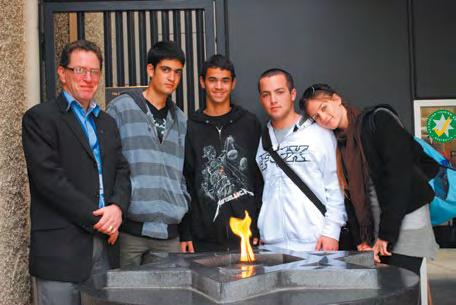



JHC Centre News 31
Pauline Rockman with Chaim Fuchs, Educator Guide for International Adult March of the Living and his son David
Joint Jewish Holocaust Centre/Cunningham Dax Collection Committee for the art exhibition Out of the Dark: The Emotional Legacy of the Holocaust (l-r) Jayne Josem, Dr Eugen Koh, Gail Rockman, Dr George Halasz and Anthony Fitzpatrick
Zvi Civins with students from the Arava in Israel
Marieke Storke, JHC volunteer from Germany, with Bernard Korbman at farewell prior to her return home Visiting students from the Arava in Israel
New Acquisitions
Ursula Flicker OAM
The following are additions to the collection from April to July 2009:
1 Copy of ID Card in Polish of Mr Szlama Zelman Wolowicz sent for translation and possible tracing to archives of Bad Arolsen.
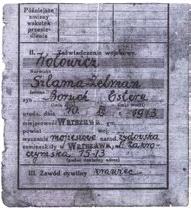
Donor: Ms Liz James
Donor: Mr Paul Sauler
2 Waffen SS cap badge
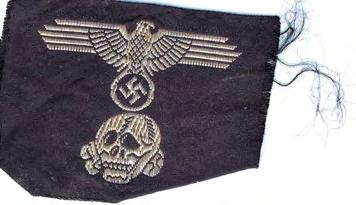
Donor: Mr Donald Gibbons
3 List produced by computer, in Polish, from information supplied about Jews from the town of Chrzanow, Poland who perished in the Holocaust

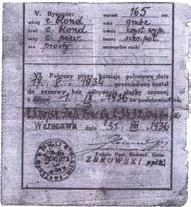
Donor: Mr Josef Weissler in Israel, received via his brother-in-law Mr S Silver
4 Copy of thesis completed as part of Graduate Diploma of Arts (Public History) 1998 at Monash University entitled A history of the Jewish Holocaust Museum and Research Centre.
Donor: Ms Kathryn Austin
The JHC Collection is a vital repository of Holocaust-era material. Artefacts and documents are carefully catalogued and stored in a state-of-the-art temperature-controlled facility to ensure their preservation for future generations. The JHC invites members of the public who have precious items relating to the Holocaust to consider donating them to our collection for safekeeping.
Through Our Eyes –A Tribute to our Grandparents
Through Our Eyes – A Tribute to our Grandparents will be a heartfelt testimony to Holocaust survivors by the third generation. A beautifully designed coffee-table style book, it will enable future generations to read and reflect on their family history and thus ensure that it will never be forgotten.
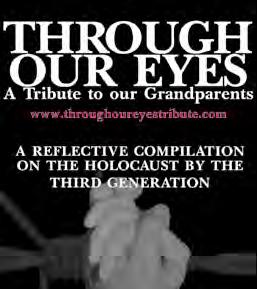
The book will give Australian grandchildren the opportunity to recount their grandparents’ journey through poems, short stories, anecdotes, drawings, paintings and collages. Edited by Sue Goldberg, it will be replete with love and hope. Portraits of grandchildren with their grandparents will ensure that this keepsake is cherished for generations to come.
All net profits from the sale of this book will go to the JHC.
For further information, visit the website: www.throughoureyes.com
JHC Centre News 32
5 Photograph of donor’s parents who together with younger brother perished in Auschwitz in 1943.
COLLECTIONS
Polish ID card, Warsaw 1936
Waffen SS cap badge
Mr & Mrs Sauler
Dr Herbert Bower
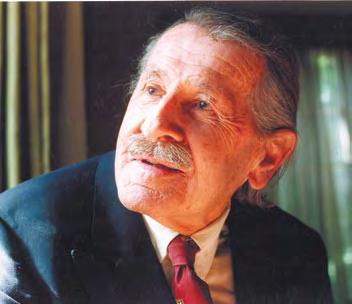 Humphrey Bower
Humphrey Bower
Humphrey Bower writes of his father’s work in assisting Holocaust survivors to seek restitution payments from the German Government after World War II.
From 1962 (the year before I was born) until 1975, my father conducted psychiatric examinations of hundreds of Holocaust survivors who, like him, had emigrated to Australia and were living in Melbourne. They were seeking disability payments from the Federal Republic of Germany and were referred to my father––a German-speaking psychiatrist––by the German consulate, which coincidentally was situated just around the corner from our house in South Yarra.
He saw them after work in his study at our home in Domain Road. I remember passing them in the hallway sometimes when I came home from school; the sound of muffled voices speaking a language I could not understand; and the sound of his typewriter as he worked on his reports until late into the night.
I believe that for my father this work was, literally, a labour of love. It was a kind of ‘moonlight’ activity, conducted outside of normal hours, on the fringe of his busy professional life, and to some extent outside of the public eye. This is consistent with the way he compartmentalised his own experience of loss, preferring to dwell on the positive side of life in general and his own fortunes.
He himself was a Viennese Jew, whose own parents perished in the Holocaust. His father was a prominent publisher and his mother had been a talented pianist before becoming a wife and mother. I have the impression that they were typical, ‘assimilated’ middle-class Jews, who did not see themselves as particularly ‘Jewish’ (my father was baptised a Protestant and went to a Scotch Presbyterian school). So, perhaps, they did not believe they were in serious danger of persecution. However, they had sufficient foresight to insist that my father leave Vienna after the German invasion of Austria in 1938, and complete his medical studies in Switzerland. According to him, there was added impetus for his departure, as he had submitted his name as a volunteer to stand guard at polling booths in case of Nazi harassment during the proposed plebiscite on Austrian autonomy (which, in the event, never took place––at least not under free or democratic conditions). He would therefore have been a marked man after the invasion, irrespective of his ethnic background. He graduated from Basel University in 1938, was advised not to return to Vienna, and escaped from Europe to Australia just before war was declared in 1939. Eventually he received notification from the Red Cross that his parents had died in the Theresienstadt ghetto. After my father’s death, I contacted the Beit Theresienstadt Martyrs Remembrance Association and learned that my grandparents were transported there from Vienna in August 1942. They were then transported to Auschwitz and murdered in the gas chambers in October 1944. I will never know if my father knew this final horrifying chapter, but he must have suspected it. I certainly did, but for some reason I waited until after his death to have it confirmed.
Did my father share anything of his story with the men and women who came into his study? I doubt it; but I have no doubt that it was there, at the back of his mind, as he sat at his desk listening to them speak. Neither victim nor survivor himself in the usual sense of those terms, perhaps he knew all too well what the GermanJewish philosopher Adorno called ‘the drastic guilt of one who was spared’. He told me that he wrestled with his conscience with regard to the fate of his parents, and the possibility or impossibility of helping them. Did he now revisit old wounds, torn between the demands of medical and even legal objectivity, and the desire to help these suffering people, who were not even strictly speaking his patients?
I do not know the outcome of their individual claims for compensation. However, in 1976, he delivered a paper at the World Congress of Psychiatry in Jerusalem on ‘The Concentration Camp Syndrome’, which he believed was a specific clinical entity related to the uniquely traumatic ‘death-experience’ undergone by those interned in the camps. This paper was based on two hundred of the interviews he had conducted over the preceding decade, which now formed a unique body of research. He must have submitted carbon copies of his reports to the German consulate, as he kept the originals.
I came across these tattered, yellowing, typewritten documents in a cupboard at Domain Road after his death in 2004. Everything had been meticulously preserved. Two manila folders labelled ‘Under 16’ and ‘Over 20’ (the claimants’ age at the time they were incarcerated) each contained reports numbered from ‘1’ to ‘100’, the cases he used as evidence for his Jerusalem paper. The rest were in a few thick, ragged piles, bound together with string. The form of each report written over a thirteen-year period is identical. Each is two to three pages long, written in German, and opens with the customary salutation, ‘Sehr geeherter Herr Kollegen (Most esteemed colleague)’. They were addressed to the original referring doctor, who presumably liaised directly with the German consulate, while my father remained at a professional arm’s length. Indeed, the style of the reports is superficially masked by a certain crisp, almost dispassionate brevity. However, through this mask, my father’s voice and his empathy can be clearly heard, together with the testimony of the men and women who told him their stories; and beyond them, the voices of those millions, like my grandparents, who were silenced.
JHC Centre News 33
STORIES FROM THE COLLECTION
Dr Herbert Bower
The Shtick Pays Its Respect to JHC
The Shtick is a weekly Channel 31 TV program and podcast of improvised Jewish entertainment television, showcasing all facets of Jewish life, including music, art, culture, humour, politics, religion, food, education and sport.
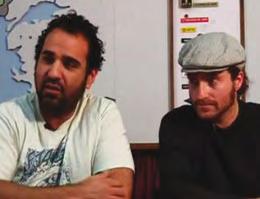
In July 2009, the Shtick team devoted an entire episode to the work of the Jewish Holocaust Centre.
The program consisted of interviews with a number of the Centre’s staff members, guides and special guests. As well as discussing the work of the Centre over the past 25 years, the program also looked at future plans, including the upgrade of the museum commencing at the end of this year and the innovative interactive technology which will be used.
The show has been split into three segments which you can view by visiting the JHC website: www.jhc.org.au
Home Care Assistance for Holocaust Survivors

Jewish Care offers assistance with home care services for Holocaust survivors living in Victoria. Austrian or Hungarian Holocaust survivors living in Victoria may also be eligible for an additional special Claims Conference program that can assist with other needs, such as medical expenses. For more information, please contact Magalí Kaplan at Jewish Care on 8517 5930.

What’s on at the Jewish Museum of Australia
All events are at the Jewish Museum unless otherwise stated. Phone: 8534 3600

Loti Smorgon Gallery
15 October 2009 – 14 February 2010
Women in the Bible: Tricksters, Victors and (M)others Juxtaposing old and new artworks, the exhibition examines representations of women in the Bible and questions traditional notions of femininity.
14 March – 19 September 2010
Between Reality and Duplicity: Standing alongside Paul and Leo –Drawings from Theresienstadt
A collection of 142 drawings and watercolours created in Theresienstadt by Paul Schwartz and Leo Lowit from 1941 to 1944, before their murder in Auschwitz.
Gross Gallery
7 October – 8 November
Rodney Glick Master of Prayer
A challenging installation which recreates the thrice daily Jewish prayer service in the Orthodox tradition, replacing the quorum of ten worshippers with computers.
20 December 2009 - 17 January 2010
Jewish Care Studio Voices
An exhibition of recent works produced by four artists representing Jewish Care’s Art Studio Space.
24 January - 21 February 2010
Tsvia Aran Shapir Sculpture
Organic, abstracted ideas, combining lyricism and ambiguity. Jewish Walks through Marvellous Melbourne Sundays 10.15am. Bookings essential, through Annette Bagle, 8534 3600.
13 September Melbourne City Centre
18 October East Melbourne
8 November Flinders Lane
Public Programs
October Free entry
‘My Favourite Biblical Female Character’
The museum joins with the Jewish, Christian, Muslim Association to present a Sunday afternoon of harmony, with speakers, a guided tour of Women in the Bible, and a celebratory light tea.
December
‘A Tale of Two Women – A Multifaith Dialogue on the Sarah/Hagar Narrative’
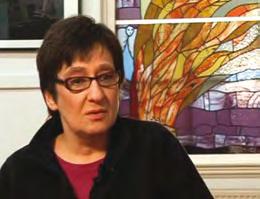
A panel of speakers from the three major Abrahamic faiths will provide different perspectives on this story.
February 2010
‘From Image to Icon – Biblical Figures in Art’
An expert panel will examine why a particular image of a biblical figure becomes the iconic image.
To find out more about public programs and permanent exhibitions visit our website www.jewishmuseum.com.au. To receive a monthly email to keep you up to date with events, public programs and exhibitions, email email@jewishmuseum.com.au, including your name and phone number.
JHC Centre News 34
OBITUARIES
Rosa (Ruszka) Goldblum: Touching the Lives of Thousands
Ruszka was born in Piotrkow on 20 August 1921, the third of Moshe and Chaja Lasman’s four children. When she was four years old, her family moved to Lodz, where her father worked as a waiter in a hotel. Her family spoke Yiddish and Polish at home.
Ruszka described her childhood as happy. She and her siblings went to a Jewish school. Her parents were members of the Bund, and Ruszka belonged to SKIF.
As it was considered more important to educate boys than girls, Ruszka was trained to become a linker (sock maker) and made socks by machine at home.
Soon after World War II began, Ruszka’s family moved to Tuszyn, her father’s birthplace. A few days later the Germans moved the family into the Piotrkow ghetto. In 1941, she married Laibl, whom she had first met when she was sixteen years old.
In October 1942, most of the Jews of the Piotrkow Ghetto were sent to their deaths at Treblinka concentration camp. However, Ruszka, together with her father, her older sister

Miriam and her husband were sent to Blizny Concentration Camp. Miriam died there of typhus in March 1943, in Ruszka’s arms. Ruszka also had typhus but managed somehow to survive.
In August 1944, Ruszka, Laibl and her father were sent to Auschwitz-Birkenau. Later, Ruszka was moved to the Kratzau Concentration Camp near Prague. On 9 May 1945, this camp was liberated by the Soviet troops. Ruszka, who had weighed 65kg before the war, now weighed just 39kg. Ruszka returned to Piotrkow, where she was reunited with Laibl, who told her that her father had perished in the gas chambers of Auschwitz-Birkenau. About sixty members of Ruszka’s extended family were killed during the Holocaust.
In 1946, one week after the Kielce pogrom, Ruszka and Laibl moved to Germany, where Ruszka worked in the kitchen of a TB hospital. They then moved to Paris where her brother and cousin were living.
Ruszka wanted to move to Israel but Laibl did not, and they eventually decided to come to Australia. They arrived in Melbourne on 6 October 1951. Ruszka worked as a finisher in a clothing factory; Laibl worked as a presser and later became a manager. For many years Ruszka was a Yiddish teacher at the Peretz Yiddishe Schule, while Laibl was the honorary treasurer of the school. In 1985, Ruszka became a volunteer guide at the Jewish Holocaust Centre where she worked for twenty years.
Ruszka was a very generous person and a devoted wife to Laibl, who passed away in 1996. Ruszka passed away peacefully on 3 July 2009. Whilst Ruszka and Laibl had no children or nieces or nephews, Ruszka’s legacy lives on in many ways – through the thousands of people she guided through the Jewish Holocaust Centre; the hundreds of children to whom she taught Yiddish; and in the hearts of her relatives and friends whom she touched with her warmth, honesty and love.
This is a shortened version of the eulogy given by Rosa’s cousin, Danny Leber, at her funeral.
Jewish Holocaust Centre
Wedding Anniversaries
50th Wedding Anniversary
Sandra & Henri Korn
38th Wedding Anniversary
Daniel & Sue Feldman
60th Wedding Anniversary
ursula & Felix Flicker
61st Wedding Anniversary
Cesia & Abe Goldberg
Wedding
Helen Borenstejn & Paul Greenberg
Engagement
Leigh Hofman & David Cutler
Birthdays
70th Birthday
Annette Mileikowski
60th Birthday
Daniel Feldman
Bab Metter
Birth of Great Grandsons
Jaxon Tye Siegel to Rosa Krakowska
Tyler Raleigh to Miriam & Tuvia Lipson
Birth of Grandsons
Charlie Abraham Herz & Ezra Walter Weiss to Rhona & Eric Herz
Cooper Abe Crespin to Bronia & John Witorz
Sam Brostek to Marika & Allen Brostek
Condolences
Rosa Goldblum
Richard Pratt
Victor Smorgon AC
Taj Bear Spencer
My parents Moshe
and siblings
Adela, Mirla, Shulem Yitzhok, Bluma, Bajla, Miriam & Abraham Cykiert
Remembered by daughter, Tove Tauber, children and grandchildren
The Jewish Holocaust Centre gratefully acknowledges the generous and on-going financial support of Clara Weis, survivor guide.
JHC Centre News 35
Szyja
and Masha Cykiert
Rosa Goldblum
The following occasions were marked with donations to the
Photo: Shoshana Jordan
Thanks In Memoriam
Support the Jewish Holocaust Centre by wearing a wristband.
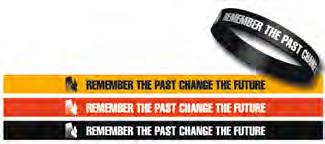


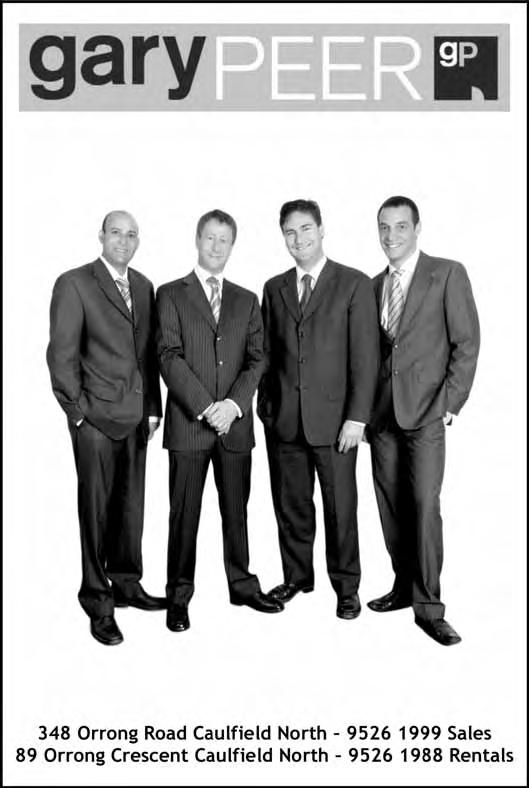
Wristbands are available at the JHC foyer. Choice of 3 colours and only $2 each

JHC Centre News 36
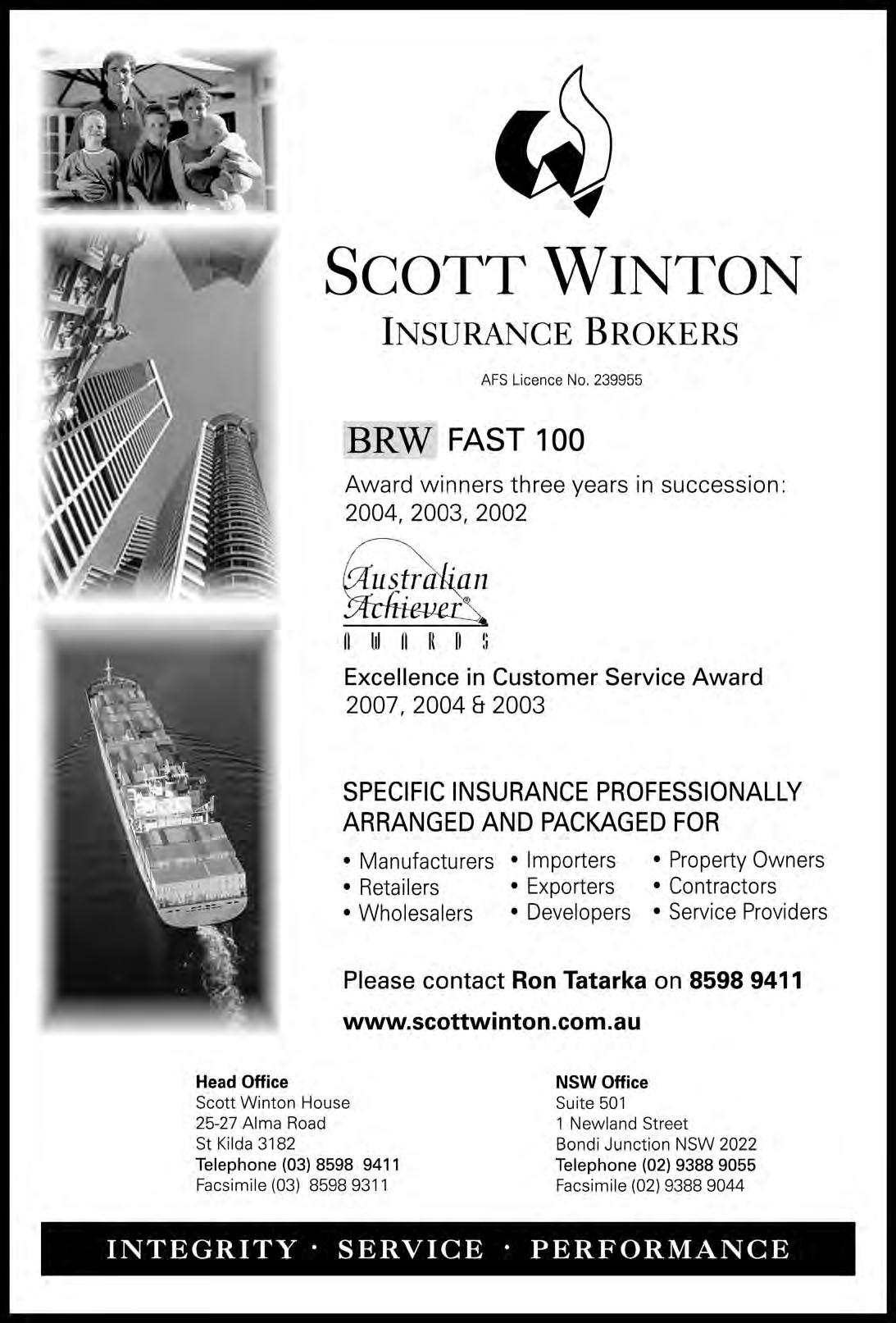
JHC Centre News 37
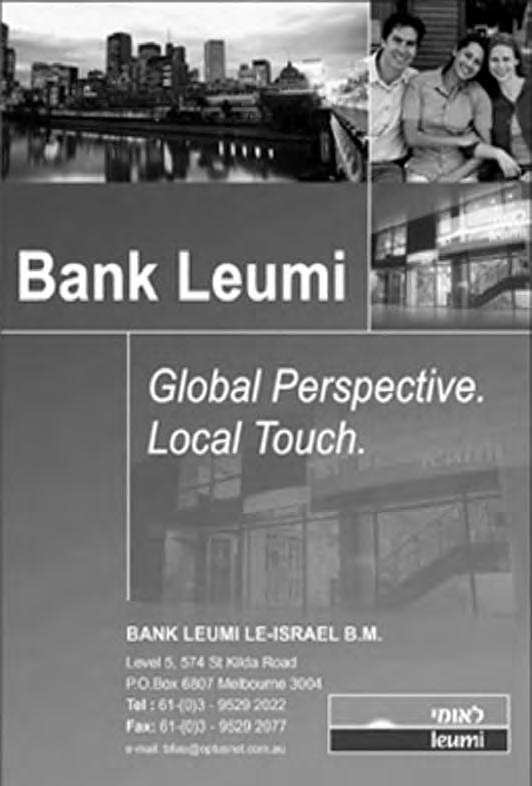

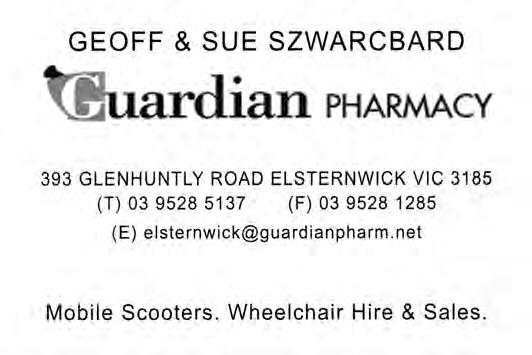
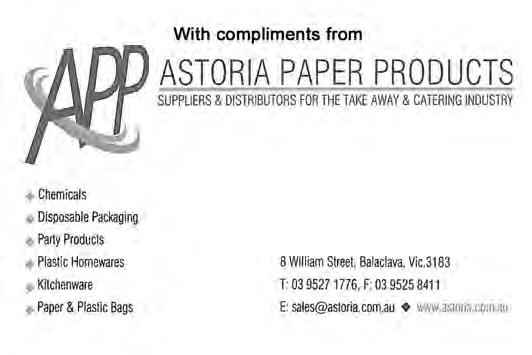

JHC Centre News 38
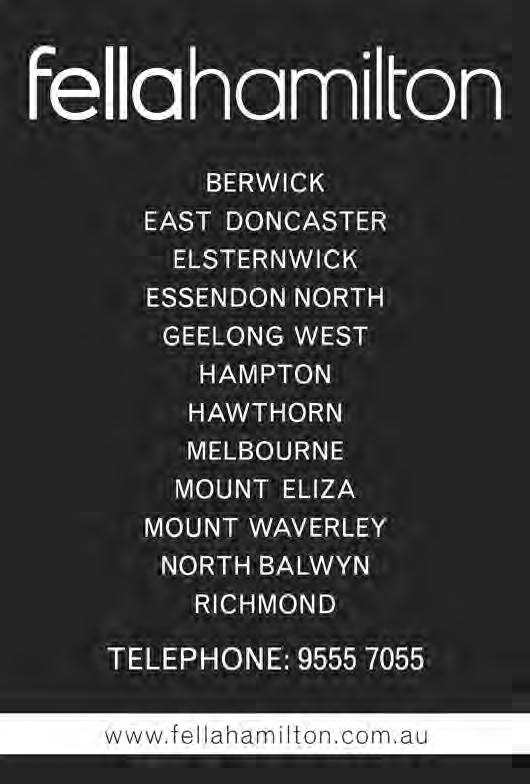


JHC Centre News 39






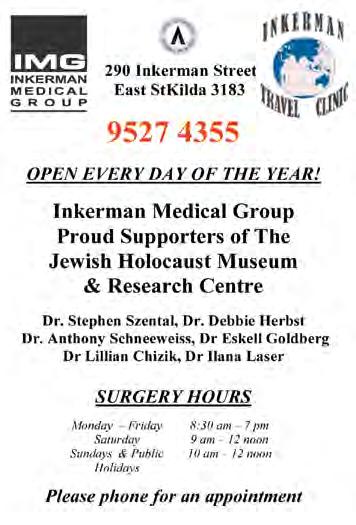
JHC Centre News 40 ADVERTISING If you would like to advertise in this section, contact Robyn Fetter at robynf@jhc.org.au or Tosca Birnbaum at admin@jhc.org.au t: (03) 9528 1985
41 JHC Centre News
JHC Centre News 42
43 JHC Centre News
September 2009 Jewish Holocaust Centre
CALENDAR OF EVENTS 2009 The Jewish Holocaust Centre
18 October: Spots of Light: to be a Woman in the Holocaust Exhibition

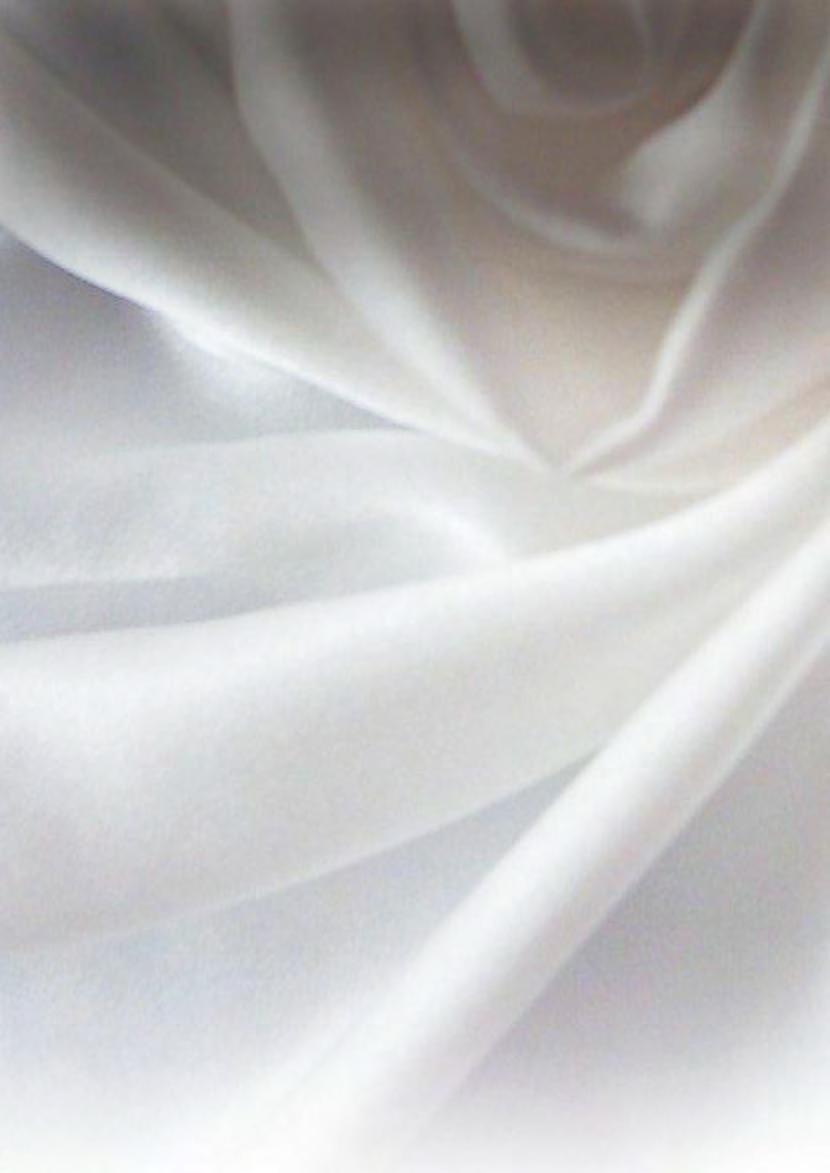
Yad Vashem’s multi-media exhibition comes to Melbourne. Exhibition opening at 3:00pm in the Smorgon Auditorium, JHC.
Public programs from October to December include Survivors and Next Generation Intergenerational Women’s function, Rachel Berger Q&A, Women in Genocide discussion panel and Promoting the Strength of Women function. Check www.jhc.org.au for details.
22 October: Shoah Foundation Director’s Visit

Public address by Stephen Smith, recently appointed Executive Director of the USC Shoah Foundation Institute.
Time: 11:00am at the Marejn Auditorium, JHC.

From 22 October: Out of the Dark: The Emotional Legacy of the Holocaust
A joint Cunningham Dax Collection–JHC exhibition of 200 art-as-therapy works by child survivors and children of Holocaust survivors. Exhibition launch by Geraldine Doogue, radio and television presenter, on Wednesday 4 November at 7:00pm at the Cunningham Dax Collection Gallery, Poplar Road, Parkville. The exhibition and public programs run from October to December. Check www.jhc.org.au or www.daxcollection.org.au for details.

6 December: To Life JHC Friends Art Auction
A collection of significant works by well known artists will be auctioned by prestigious art auction house Bonhams and Goodman, Level 1, 540 Malvern Road, Prahran at 4pm. Check www.jhc.org.au for details of viewing times.

December: JHC Museum Upgrade Construction Program
The refurbishment of the museum will commence in December 2009. Expected re-opening early in 2010.
Registered by Australia Post. Publication No. VBH 7236
UNDER
CONSTRUCTION
Suzi & Barry Carp
Anita & Danny Selzer
Melma & Berni Hamersfeld Helen & Jeffrey Mahemoff
Pauline & Sean Rockman and Sandra & Vernon Jedwab Diana Strauss
The Helen and Boris Liberman Family The Jack and Robert Smorgon Families Foundation Sunraysia Foundation in memory of J and D Randa























































 Looking down at the seder at the home of Sue and Phil Lewis
Looking down at the seder at the home of Sue and Phil Lewis


 Elly Brooks, Helen Mahemoff, Frankie Pinch, Pauline Rockman and Lionel Sharp
StoryPod IT consultants and RMIT graduates (Nat) Buddhiporn Palakawong Na Ayudhaya (centre) and Aukrit Chadagorn (right), with Nat’s parents
Elly Brooks, Helen Mahemoff, Frankie Pinch, Pauline Rockman and Lionel Sharp
StoryPod IT consultants and RMIT graduates (Nat) Buddhiporn Palakawong Na Ayudhaya (centre) and Aukrit Chadagorn (right), with Nat’s parents





























 Humphrey Bower
Humphrey Bower





























